 Noach, Noiach, Nauach, Nauah, or Noah (,
Noach, Noiach, Nauach, Nauah, or Noah (, Readings
In traditional Sabbath Torah reading, the parashah is divided into seven readings, or , '' aliyot'', and a shorter reading called the Maftir, or , which is usually made up of the last few verses of the last reading. In the'' Hebrew Bible The Hebrew Bible or Tanakh (;"Tanach"
'' peh'')). Parashat Noach has several further subdivisions, called "closed portion" (, ''setumah'') divisions (abbreviated with the Hebrew letter (''

First reading — Genesis 6:9–22
In the first reading, the Torah writes thatSecond reading — Genesis 7:1–16
In the second reading, in chapter , seven days before the Flood, God told Noah to go into the Ark with his household, and to take seven pairs of every clean animal and every bird, and two pairs of every other animal, to keep their species alive. When Noah was 600 years old, the Flood came, and that same day, Noah, his family and the beasts went into the Ark, and God shut him in. The second reading ends here.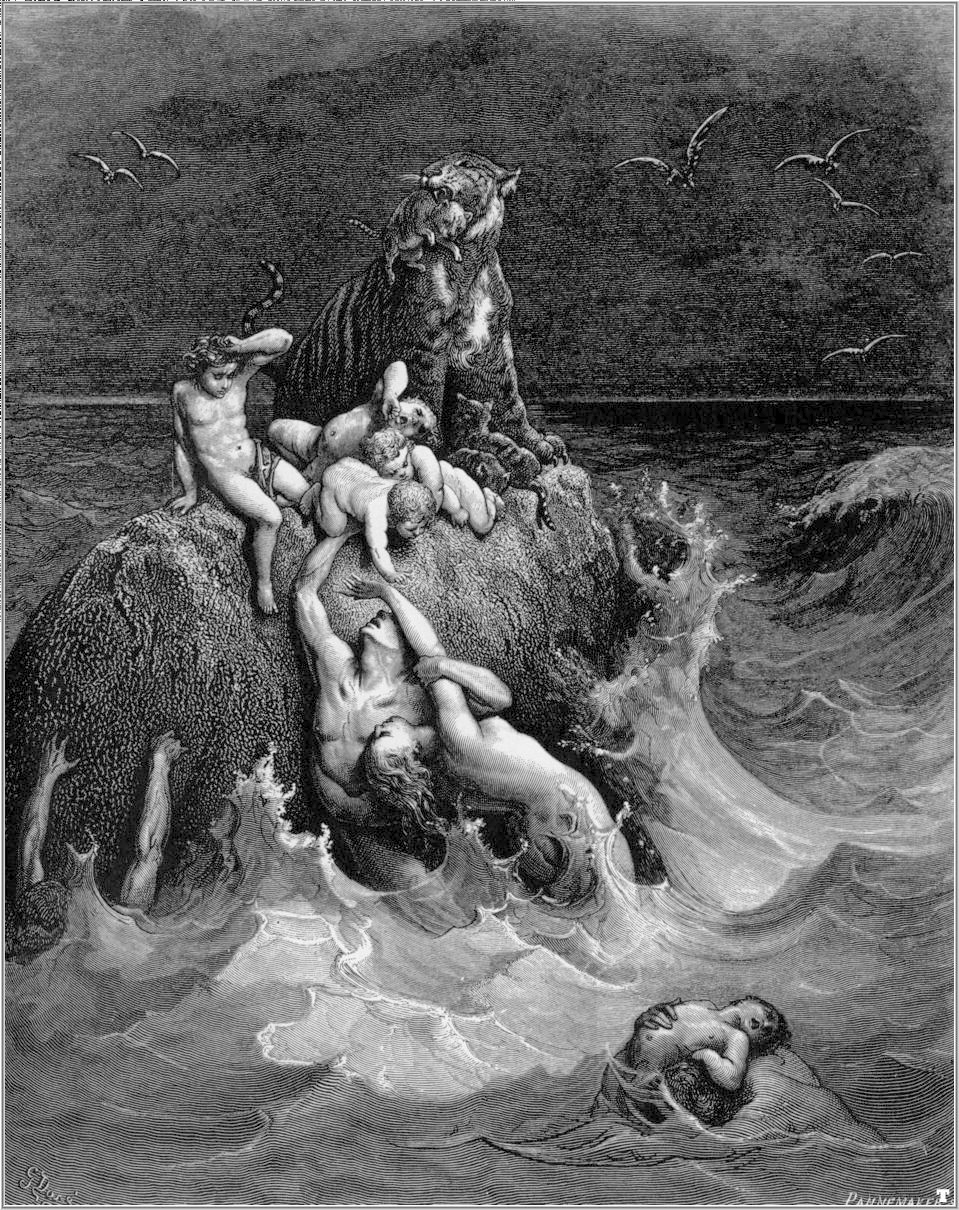

Third reading — Genesis 7:17–8:14
In the third reading, the rains fell 40 days and 40 nights, the waters swelled 15 cubits above the highest mountains, and all flesh with the merest breath of life died, except for Noah and those with him on the Ark. When the waters had swelled 150 days, God remembered Noah and the beasts, and God caused a wind to blow and the waters to recede steadily from the earth, and the Ark came to rest on the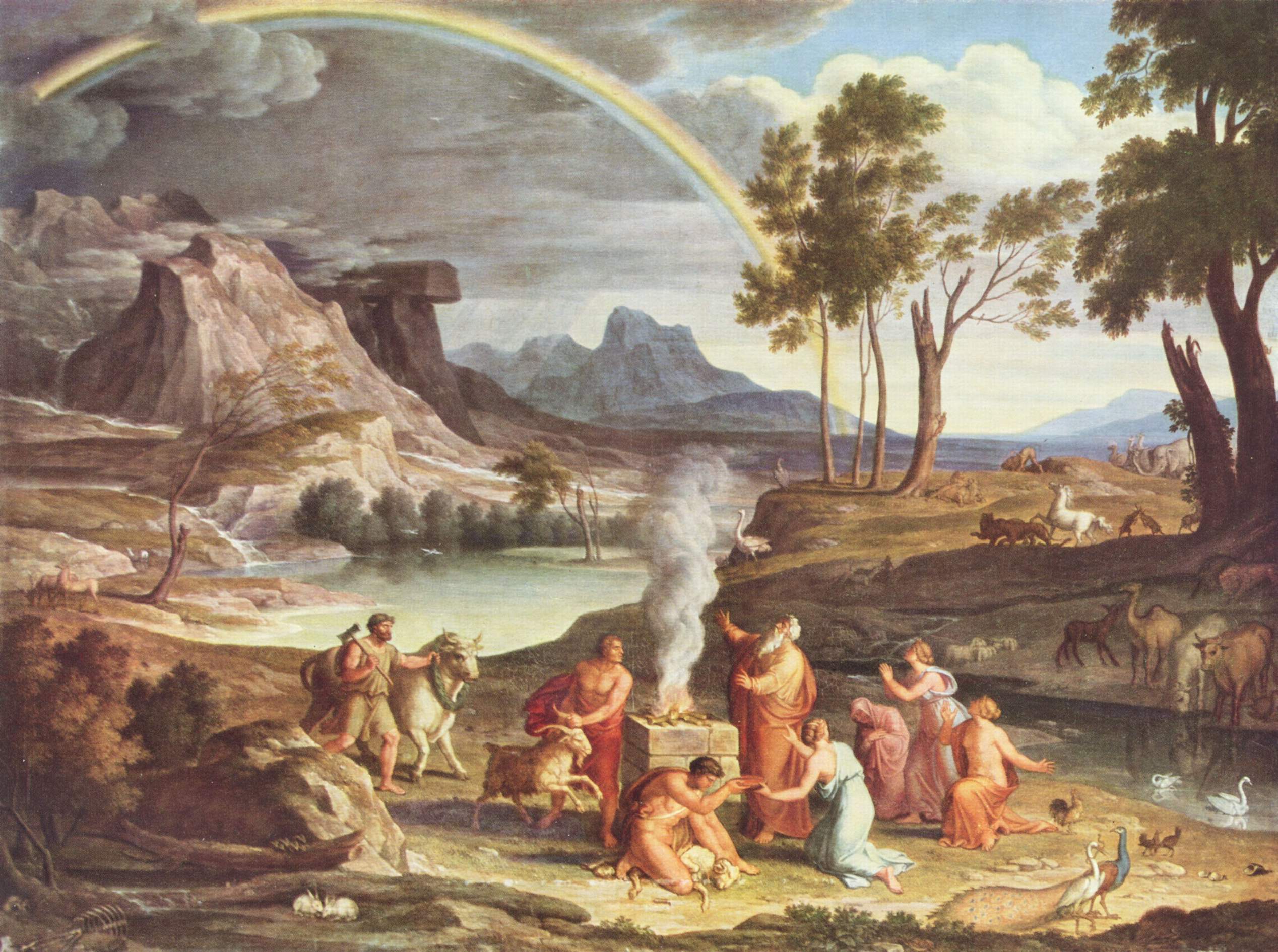
Fourth reading — Genesis 8:15–9:7
In the fourth reading, God told Noah to come out of the Ark with his family and to free the animals. Then Noah built anFifth reading — Genesis 9:8–17
In the fifth reading, God made a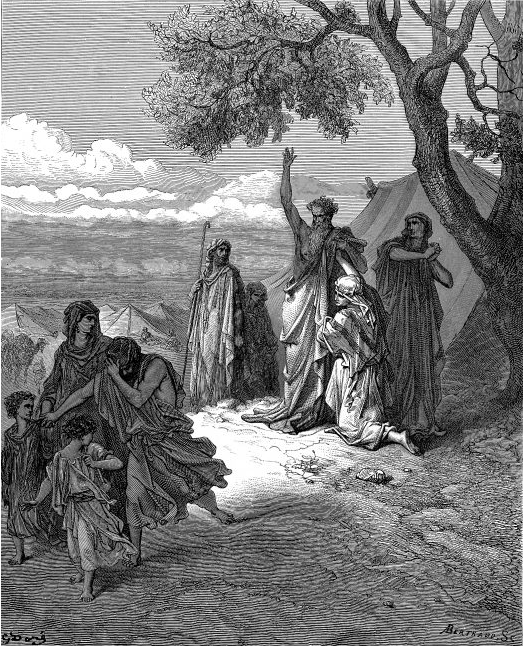
Sixth reading — Genesis 9:18–10:32
In the sixth reading, Noah became the first to plant a vineyard, and he drank himself As the reading continues, chapter sets forth the descendants of Shem, Ham, and Japheth, from whom the nations branched out over the earth after the Flood, a section known as the
As the reading continues, chapter sets forth the descendants of Shem, Ham, and Japheth, from whom the nations branched out over the earth after the Flood, a section known as the Seventh reading — Genesis 11:1–32
In the seventh reading, in chapter , everyone on earth spoke the same language. As people migrated from the east, they settled in the land of Shinar. People there sought to make bricks and build a city and a tower with its top in the sky, to make a name for themselves, so that they not be scattered over the world. God came down to look at the city and tower, and remarked that as one people with one language, nothing that they sought would be out of their reach. God went down and confounded their speech, so that they could not understand each another, and scattered them over the face of the earth, and they stopped building the city. Thus the city was calledReadings according to the triennial cycle
Jews who read the Torah according to theIn ancient parallels
The parashah has parallels in these ancient sources:Genesis chapters 6–8
 Tablet 11 of the
Tablet 11 of the In inner-biblical interpretation
The parashah has parallels or is discussed in these Biblical sources:Genesis chapter 6
The wording of , "Noah was a righteous (, ''tamim'') man," is echoed in , "the Eternal appeared to Abram and said to him, 'I am El Shaddai—walk along before Me and be pure of heart (, ''tamim'').'" In , God shared God's purpose with Noah, saying, "I have decided to put an end to all flesh," and in an internal dialogue in , God asked, "Shall I hide from Abraham what I am about to do ... ? For I have singled him out, that he may instruct his children and his posterity to keep the way of the Lord by doing what is just and right, in order that the Lord may bring about for Abraham what He has promised him." Similarly, in , the 8th century BCEGenesis chapter 11
reports that Abram's father Terah lived beyond the River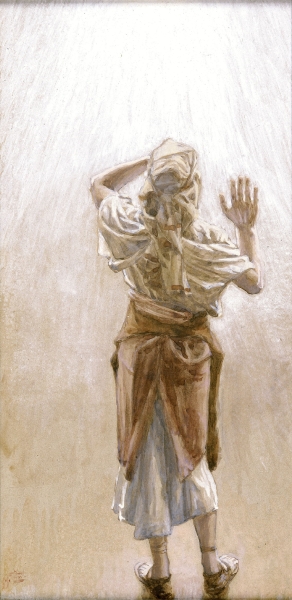
In classical Rabbinic interpretation
The parashah is discussed in theseGenesis chapter 6
Interpreting the words, "Noah was a just man, and perfect in his generations", in , Rabbi Johanan taught that Noah was considered righteous in his generations, but would not have been considered righteous in other generations. Rabbi Judah contrasted the words "Noah walked with God" in with God's words to Abraham, "walk before Me," in . Rabbi Judah compared it to a king who had two sons, one grown up and the other a child. The king asked the child to walk ''with'' him. But the king asked the adult to walk ''before'' him. Similarly, to Abraham, whose moral strength was great, God said, "Walk before Me." But of Noah, who was feeble, says, "Noah walked with God." Rabbi Nehemiah compared Noah to a king's friend who was plunging about in dark alleys, and when the king saw him sinking in the mud, the king urged his friend to walk with him instead of plunging about. Abraham's case, however, was compared to that of a king who was sinking in dark alleys, and when his friend saw him, the friend shined a light for him through the window. The king then asked his friend to come and shine a light before the king on his way. Thus, God told Abraham that instead of showing a light for God from Mesopotamia, he should come and show one before God in the
Rabbi Judah contrasted the words "Noah walked with God" in with God's words to Abraham, "walk before Me," in . Rabbi Judah compared it to a king who had two sons, one grown up and the other a child. The king asked the child to walk ''with'' him. But the king asked the adult to walk ''before'' him. Similarly, to Abraham, whose moral strength was great, God said, "Walk before Me." But of Noah, who was feeble, says, "Noah walked with God." Rabbi Nehemiah compared Noah to a king's friend who was plunging about in dark alleys, and when the king saw him sinking in the mud, the king urged his friend to walk with him instead of plunging about. Abraham's case, however, was compared to that of a king who was sinking in dark alleys, and when his friend saw him, the friend shined a light for him through the window. The king then asked his friend to come and shine a light before the king on his way. Thus, God told Abraham that instead of showing a light for God from Mesopotamia, he should come and show one before God in the ''Random House Webster's Unabridged Dictionary''. he, מִדְרָשׁ; ...
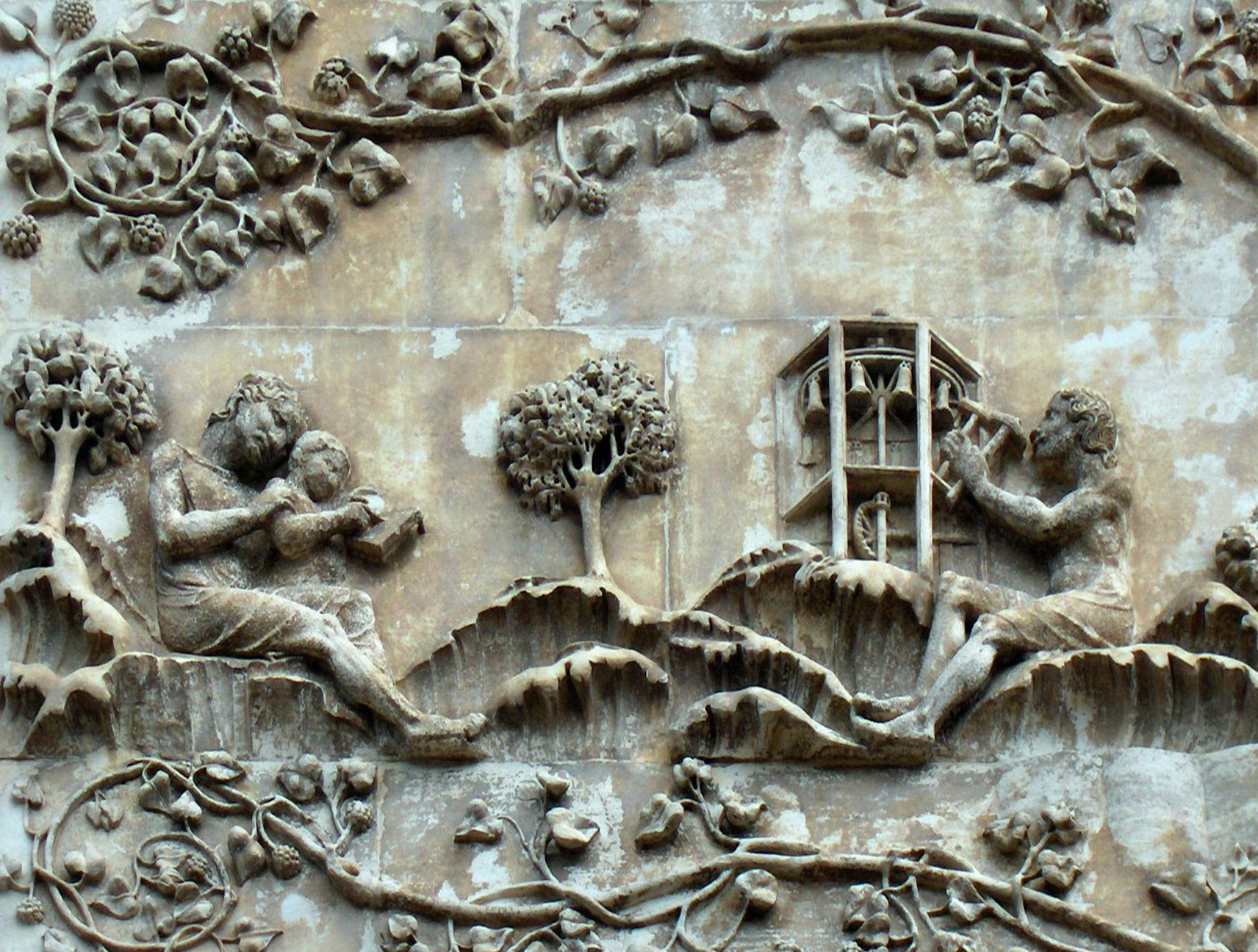 Rabbi Abba bar Kahana read together to report God saying, "I repent that I have made them and Noah." Thus even Noah, who was left, was not worthy, save that (in the words of ) "Noah found grace in the eyes of the Lord."
Rabbi Abba bar Kahana said that Naamah, the sister of
Rabbi Abba bar Kahana read together to report God saying, "I repent that I have made them and Noah." Thus even Noah, who was left, was not worthy, save that (in the words of ) "Noah found grace in the eyes of the Lord."
Rabbi Abba bar Kahana said that Naamah, the sister of in, e.g., ''Talmud Bavli''. Elucidated by Asher Dicker, Joseph Elias, and Dovid Katz; edited by Yisroel Simcha Schorr and Chaim Malinowitz, volume 49, page 108a2.
 The
The  Interpreting , Rabbi Johanan deduced that the consequences of robbery are great. For though the generation of the Flood transgressed all laws, God sealed their decree of punishment only because they robbed. In , God told Noah that "the earth is filled with violence (that is, robbery) through them, and, behold, I will destroy them with the earth." And also states, "Violence (that is, robbery) is risen up into a rod of wickedness; none of them shall remain, nor of their multitude, nor any of theirs; neither shall there be wailing for them." Rabbi Eleazar interpreted to teach that violence stood up before God like a staff, and told God that there was no good in any of the generation of the Flood, and none would bewail them when they were gone.
Similarly, Midrash interpreted the words, "the earth is filled with violence," in to teach that it was because they were steeped in robbery that they were blotted out from the world.
Interpreting , Rabbi Haninah told what the people of the age of the Flood used to do. When a person brought out a basket of beans for sale, one would come and seize less than the worth of the smallest coin in circulation, a ''perutah'' (and thus there was no redress under the law). And then everyone would come and seize less than a ''perutah's'' worth, so that the seller had no redress at law. Seeing this, God said that the people had acted improperly, so God would deal with them improperly (in a way that they would not relish).
Interpreting , Rabbi Levi taught that "violence" (, ''chamas'') connotes idolatry, sexual immorality, and murder, as well as robbery. Reference to sexual immorality appears in , which says, "The violence done to me (, ''chamasi'') and to my flesh (, ''she'eri'') be upon Babylon" (and שְׁאֵר, ''she'er'' refers to sexual immorality, for example, in ). And reference to murder appears in , which says, "for the violence (, ''chamas'') against the children of Judah, because they have shed innocent blood in their land."
Interpreting God's words in , "I will destroy them with the earth," Rav Huna and Rabbi Jeremiah in Rav Kahana's name taught that the Flood washed away even the three handbreadths of the Earth's surface that a
Interpreting , Rabbi Johanan deduced that the consequences of robbery are great. For though the generation of the Flood transgressed all laws, God sealed their decree of punishment only because they robbed. In , God told Noah that "the earth is filled with violence (that is, robbery) through them, and, behold, I will destroy them with the earth." And also states, "Violence (that is, robbery) is risen up into a rod of wickedness; none of them shall remain, nor of their multitude, nor any of theirs; neither shall there be wailing for them." Rabbi Eleazar interpreted to teach that violence stood up before God like a staff, and told God that there was no good in any of the generation of the Flood, and none would bewail them when they were gone.
Similarly, Midrash interpreted the words, "the earth is filled with violence," in to teach that it was because they were steeped in robbery that they were blotted out from the world.
Interpreting , Rabbi Haninah told what the people of the age of the Flood used to do. When a person brought out a basket of beans for sale, one would come and seize less than the worth of the smallest coin in circulation, a ''perutah'' (and thus there was no redress under the law). And then everyone would come and seize less than a ''perutah's'' worth, so that the seller had no redress at law. Seeing this, God said that the people had acted improperly, so God would deal with them improperly (in a way that they would not relish).
Interpreting , Rabbi Levi taught that "violence" (, ''chamas'') connotes idolatry, sexual immorality, and murder, as well as robbery. Reference to sexual immorality appears in , which says, "The violence done to me (, ''chamasi'') and to my flesh (, ''she'eri'') be upon Babylon" (and שְׁאֵר, ''she'er'' refers to sexual immorality, for example, in ). And reference to murder appears in , which says, "for the violence (, ''chamas'') against the children of Judah, because they have shed innocent blood in their land."
Interpreting God's words in , "I will destroy them with the earth," Rav Huna and Rabbi Jeremiah in Rav Kahana's name taught that the Flood washed away even the three handbreadths of the Earth's surface that a  Rabbi Isaac taught that God told Noah that just as a pair of birds (''ken'') cleansed a person with skin disease (as instructed in ), so Noah's Ark would cleanse Noah (so that he would be worthy to be saved from the Flood).
Rabbi Yassa noted that in four places, Scripture uses the expression, "make for yourself (, ''oseh l'cha'')." In three of those instances, God explained the material from which to make the thing, and in one God did not. says, "Make for yourself an ark of gopher wood"; says, "make for yourself two silver trumpets"; and says, "make for yourself knives of flint." But says merely, "make for yourself a fiery serpent" without further explanation. So Moses reasoned that a serpent is essentially a snake, and made the snake of copper, because in Hebrew, the word for copper (, ''nechoshet'') sounds like the word for snake (, ''nechash'').
Rav Adda taught that the scholars of Rav Shila interpreted "gopher wood" in to mean ''mabliga'' (a resinous species of
Rabbi Isaac taught that God told Noah that just as a pair of birds (''ken'') cleansed a person with skin disease (as instructed in ), so Noah's Ark would cleanse Noah (so that he would be worthy to be saved from the Flood).
Rabbi Yassa noted that in four places, Scripture uses the expression, "make for yourself (, ''oseh l'cha'')." In three of those instances, God explained the material from which to make the thing, and in one God did not. says, "Make for yourself an ark of gopher wood"; says, "make for yourself two silver trumpets"; and says, "make for yourself knives of flint." But says merely, "make for yourself a fiery serpent" without further explanation. So Moses reasoned that a serpent is essentially a snake, and made the snake of copper, because in Hebrew, the word for copper (, ''nechoshet'') sounds like the word for snake (, ''nechash'').
Rav Adda taught that the scholars of Rav Shila interpreted "gopher wood" in to mean ''mabliga'' (a resinous species of While tells that Noah's Ark had pitch "within and without", tells that
 The Gemara read the words, "and to a cubit shall you finish it upward," in to ensure that thus would it stand firm (with the sides of the roof sloping, so that the rain would fall off it).
A Tanna read the words, "with lower, second, and third stories shall you make it," in to teach that the bottom story was for the dung, the middle for the animals, and the top for Noah's family. A Midrash, however, reported that some said that the words, "with lower, second, and third stories shall you make it," meant that the bottom story was for waste, the second for Noah's family and the clean animals, and the third for the unclean animals. And the Midrash reported that others said that the bottom story was for the unclean animals, the second for Noah's family and the clean animals, and the top for the garbage. The Midrash taught that Noah managed to move the waste by arranging a kind of trapdoor through which he shoveled it sideways.
Noting that calls Noah "a man," a Midrash taught that wherever Scripture employs the term "a man," it indicates a righteous man who warned his generation. The Midrash taught that for 120 years (deduced from ), Noah planted cedars and cut them down. When they would ask him what he was doing, he would reply that God had informed him that God was bringing a flood. Noah's contemporaries replied that if a flood did come, it would come only on Noah's father's house. Rabbi Abba taught that God said that one herald arose for God in the generation of the Flood — Noah. But they despised him and called him a contemptible old man.
The Gemara read the words, "and to a cubit shall you finish it upward," in to ensure that thus would it stand firm (with the sides of the roof sloping, so that the rain would fall off it).
A Tanna read the words, "with lower, second, and third stories shall you make it," in to teach that the bottom story was for the dung, the middle for the animals, and the top for Noah's family. A Midrash, however, reported that some said that the words, "with lower, second, and third stories shall you make it," meant that the bottom story was for waste, the second for Noah's family and the clean animals, and the third for the unclean animals. And the Midrash reported that others said that the bottom story was for the unclean animals, the second for Noah's family and the clean animals, and the top for the garbage. The Midrash taught that Noah managed to move the waste by arranging a kind of trapdoor through which he shoveled it sideways.
Noting that calls Noah "a man," a Midrash taught that wherever Scripture employs the term "a man," it indicates a righteous man who warned his generation. The Midrash taught that for 120 years (deduced from ), Noah planted cedars and cut them down. When they would ask him what he was doing, he would reply that God had informed him that God was bringing a flood. Noah's contemporaries replied that if a flood did come, it would come only on Noah's father's house. Rabbi Abba taught that God said that one herald arose for God in the generation of the Flood — Noah. But they despised him and called him a contemptible old man.
 Similarly, Rabbi Jose of
Similarly, Rabbi Jose of  And Rava interpreted the words of , "He that is ready to slip with his feet is as a stone despised in the thought of him that is at ease," to teach that when Noah rebuked them and spoke words as hard as fiery flints, they would deride him. They called Noah "old man," and asked him what the Ark was for. Noah replied that God was bringing a flood upon them. They asked with what God would flood the earth. If God brought a flood of fire, they said, they had a thing called alitha (that would extinguish fire). If God brought a flood of water up from the earth, they said, they had iron plates with which they could cover the earth (to prevent the water from coming up). If God brought a flood of water from heaven, they said, they had a thing called akob (or some say akosh) (that could ward it off). Noah replied that God would bring it from between the heels of their feet, as says, "He is ready for the steps of your feet."
A Midrash compared Noah to Moses and found Moses superior. While Noah was worthy to be delivered from the generation of the Flood, he saved only himself and his family, and had insufficient strength to deliver his generation. Moses, however, saved both himself and his generation when they were condemned to destruction after the sin of the
And Rava interpreted the words of , "He that is ready to slip with his feet is as a stone despised in the thought of him that is at ease," to teach that when Noah rebuked them and spoke words as hard as fiery flints, they would deride him. They called Noah "old man," and asked him what the Ark was for. Noah replied that God was bringing a flood upon them. They asked with what God would flood the earth. If God brought a flood of fire, they said, they had a thing called alitha (that would extinguish fire). If God brought a flood of water up from the earth, they said, they had iron plates with which they could cover the earth (to prevent the water from coming up). If God brought a flood of water from heaven, they said, they had a thing called akob (or some say akosh) (that could ward it off). Noah replied that God would bring it from between the heels of their feet, as says, "He is ready for the steps of your feet."
A Midrash compared Noah to Moses and found Moses superior. While Noah was worthy to be delivered from the generation of the Flood, he saved only himself and his family, and had insufficient strength to deliver his generation. Moses, however, saved both himself and his generation when they were condemned to destruction after the sin of the  Reading God's words to Noah in , "But I will establish My covenant with you," a Midrash taught that God was telling Noah that he would need a covenant to ensure that the produce would not decay or rot on the Ark. Further, the Midrash taught, Noah needed a covenant to prevent giants from plugging the openings of the deep and seeking to enter the Ark. And Noah needed a covenant to prevent additional lions from coming into the Ark. Rabbi Hiyya bar Abba explained that God was thus telling Noah that though he may have built the Ark, but for God's covenant, Noah could not have entered the Ark. Thus Noah's ability to enter the Ark at all was proof of the covenant God established with Noah in .
Rabbi Hanan said in the name of Rabbi Samuel ben Isaac that as soon as Noah entered the Ark, God prohibited his family from cohabitation, saying in "you shall come into the Ark, you, and your sons," speaking of them apart, and, "your wife, and your sons' wives," speaking of them apart. When Noah left the Ark, God permitted cohabitation to him again, saying in "Go forth from the Ark, you and your wife," speaking of them together. Similarly, Rabbi Johanan deduced from the same sources that God had forbidden cohabitation for all the Ark's inhabitants. The Rabbis taught in a Baraita that three nonetheless cohabited in the Ark — the dog, the raven, and Ham — and they were all punished.
Reading God's words to Noah in , "But I will establish My covenant with you," a Midrash taught that God was telling Noah that he would need a covenant to ensure that the produce would not decay or rot on the Ark. Further, the Midrash taught, Noah needed a covenant to prevent giants from plugging the openings of the deep and seeking to enter the Ark. And Noah needed a covenant to prevent additional lions from coming into the Ark. Rabbi Hiyya bar Abba explained that God was thus telling Noah that though he may have built the Ark, but for God's covenant, Noah could not have entered the Ark. Thus Noah's ability to enter the Ark at all was proof of the covenant God established with Noah in .
Rabbi Hanan said in the name of Rabbi Samuel ben Isaac that as soon as Noah entered the Ark, God prohibited his family from cohabitation, saying in "you shall come into the Ark, you, and your sons," speaking of them apart, and, "your wife, and your sons' wives," speaking of them apart. When Noah left the Ark, God permitted cohabitation to him again, saying in "Go forth from the Ark, you and your wife," speaking of them together. Similarly, Rabbi Johanan deduced from the same sources that God had forbidden cohabitation for all the Ark's inhabitants. The Rabbis taught in a Baraita that three nonetheless cohabited in the Ark — the dog, the raven, and Ham — and they were all punished.

Genesis chapter 7
Reading in the command that "of every clean beast you shall take seven, man and wife," the Gemara asked whether beasts have marital relationships. Rabbi Samuel bar Nahman said in Reading in the command to take into the Ark "of the fowl also of the air, seven each," a Midrash hypothesized that the command might have meant seven of each kind of animal (three of one gender and four of the other). But then one of them would lack a mate. Hence the Midrash concluded that God meant seven males and seven females. Of course God did not need them, but they were to come (in the words of ) "to keep seed alive upon the face of all the earth."
Rabbi Simeon ben Yohai taught that because the generation of the Flood transgressed the Torah that God gave humanity after Moses had stayed on the mountain for 40 days and 40 nights (as reported in and and
Reading in the command to take into the Ark "of the fowl also of the air, seven each," a Midrash hypothesized that the command might have meant seven of each kind of animal (three of one gender and four of the other). But then one of them would lack a mate. Hence the Midrash concluded that God meant seven males and seven females. Of course God did not need them, but they were to come (in the words of ) "to keep seed alive upon the face of all the earth."
Rabbi Simeon ben Yohai taught that because the generation of the Flood transgressed the Torah that God gave humanity after Moses had stayed on the mountain for 40 days and 40 nights (as reported in and and 18
and ), God announced in that God would "cause it to rain upon the earth 40 days and 40 nights." Similarly, Rabbi Johanan taught that because the generation of the Flood corrupted the features that take shape after 40 days (in the womb), God announced in that God would "cause it to rain upon the earth 40 days and 40 nights, and every living substance that I have made will I blot out."Genesis Rabbah 32:5
in, e.g., ''Midrash Rabbah: Genesis''. Translated by Harry Freedman and Maurice Simon, volume 1, page 352.
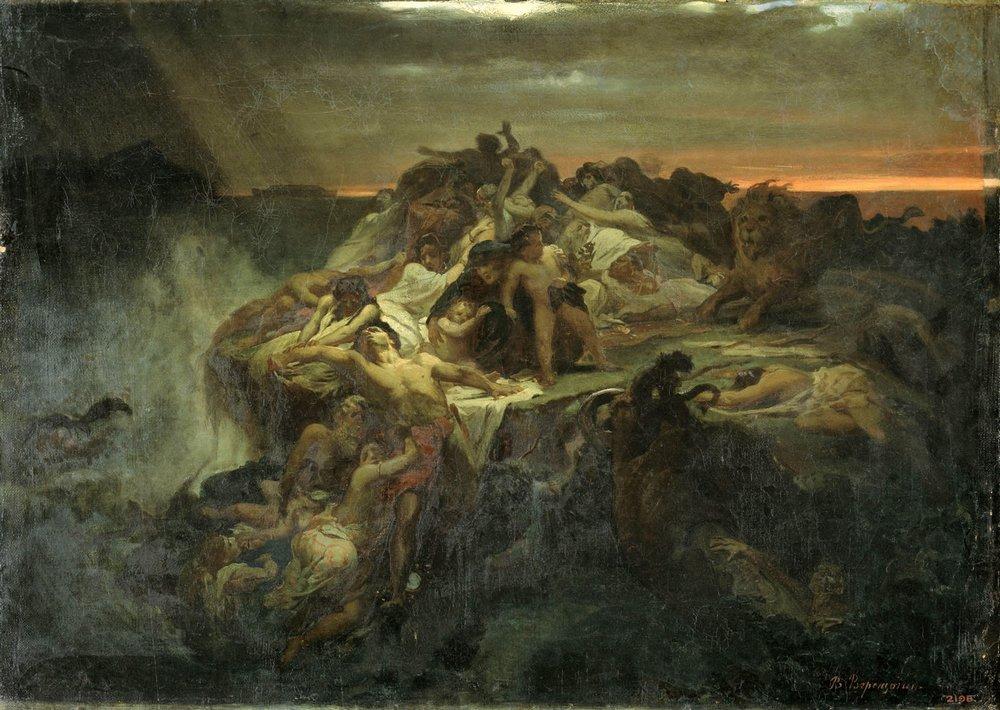 Reading in that God said, "every living substance (, ''yekum'') that I have made will I blot out," Rabbi Abin taught that this included the one who rose up (, ''yakam'') against his brother —
Reading in that God said, "every living substance (, ''yekum'') that I have made will I blot out," Rabbi Abin taught that this included the one who rose up (, ''yakam'') against his brother —  The Gemara read to employ the euphemistic expression "not clean," instead of the brief, but disparaging expression "unclean," so as not to speak disparagingly of unclean animals. The Gemara reasoned that it was thus likely that Scripture would use euphemisms when speaking of the faults of righteous people, as with the words, "And the eyes of
The Gemara read to employ the euphemistic expression "not clean," instead of the brief, but disparaging expression "unclean," so as not to speak disparagingly of unclean animals. The Gemara reasoned that it was thus likely that Scripture would use euphemisms when speaking of the faults of righteous people, as with the words, "And the eyes of 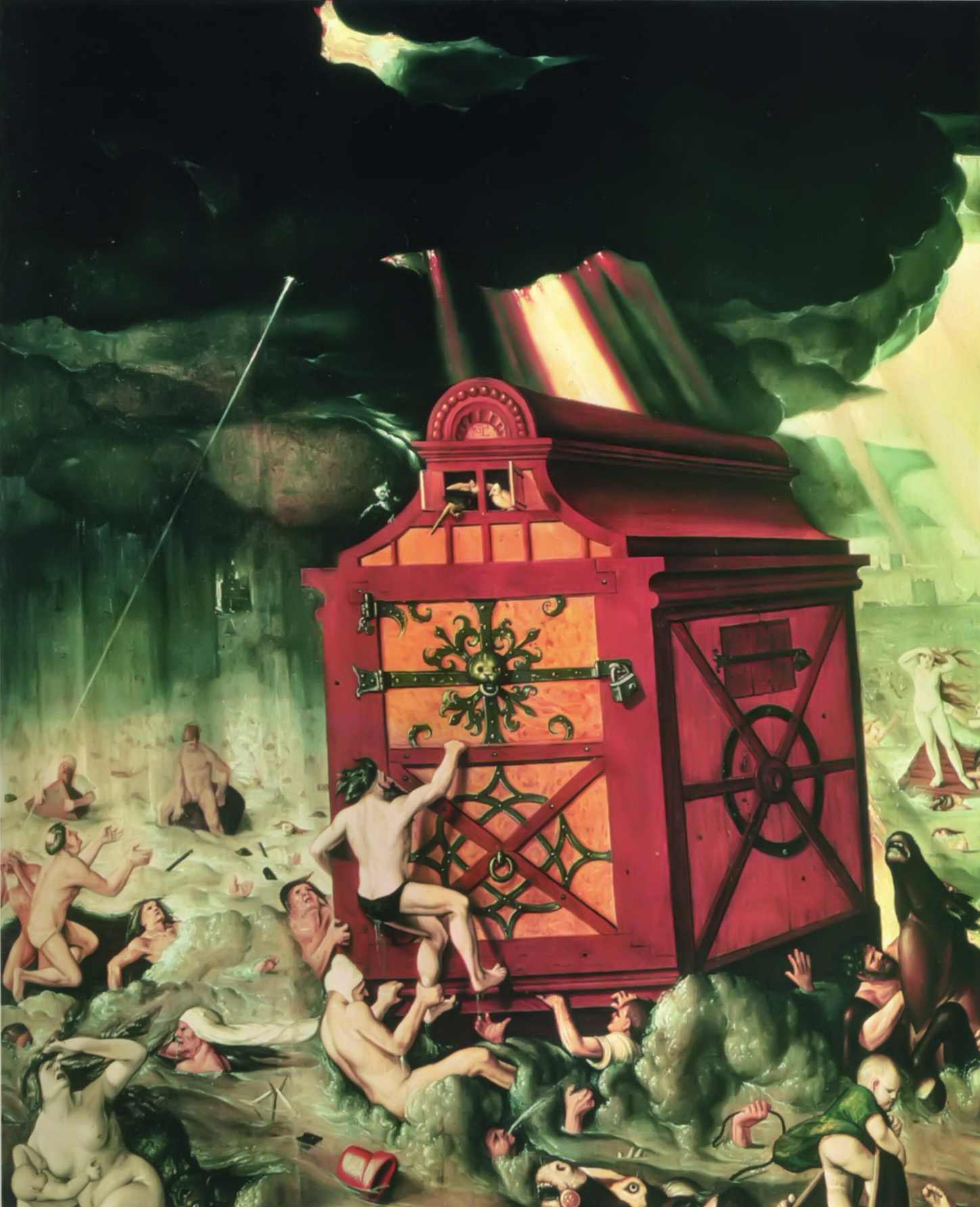 Similarly, the
Similarly, the 
 In a Baraita, Rabbi Eleazar of Modi'im interpreted , "Fifteen cubits upward did the waters prevail; and the mountains were covered." Rabbi Eleazar of Modi'im asked whether waters that measured fifteen cubits high on the mountains could also measure fifteen cubits in the valley. To do so, the waters would have to stand like a series of walls (terraced with the topography). And if so, the ark could not have come to rest on the top of the mountains. Rather, Rabbi Eleazar of Modi'im taught that all the fountains of the great deep came up first until the water was even with the mountains, and then the water rose fifteen more cubits.
Reading in that "all that was on the dry land died," the Gemara deduced that the fish in the sea did not die (apparently not having committed the transgressions that land animals had).
The Tosefta taught that the Flood killed people before animals (as seen in the order of ), because man sinned first (as shown in ).
In a Baraita, Rabbi Eleazar of Modi'im interpreted , "Fifteen cubits upward did the waters prevail; and the mountains were covered." Rabbi Eleazar of Modi'im asked whether waters that measured fifteen cubits high on the mountains could also measure fifteen cubits in the valley. To do so, the waters would have to stand like a series of walls (terraced with the topography). And if so, the ark could not have come to rest on the top of the mountains. Rather, Rabbi Eleazar of Modi'im taught that all the fountains of the great deep came up first until the water was even with the mountains, and then the water rose fifteen more cubits.
Reading in that "all that was on the dry land died," the Gemara deduced that the fish in the sea did not die (apparently not having committed the transgressions that land animals had).
The Tosefta taught that the Flood killed people before animals (as seen in the order of ), because man sinned first (as shown in ).

Genesis chapter 8
Reading "and he sent forth a raven" in , Resh Lakish taught that the raven gave Noah a triumphant retort, arguing that both God and Noah must have hated the raven. It was evident that God hated the raven because God commanded Noah to save seven pairs of the clean creatures on the Ark, but only two of the unclean (among which the raven counted itself under ). And it was evident that Noah hated the raven because Noah had left in the Ark the species of which there were seven pairs, and sent one of which there were only two. If the Similarly, interpreting the words, "and it went forth to and fro" in , Rabbi Judan said in the name of Rabbi Judah ben Rabbi Simon that the raven began arguing with Noah. The raven asked Noah why of all the birds that Noah had in the Ark Noah sent none but the raven. Noah retorted that the world had no need of the raven; the raven was fit neither for food nor for sacrifice.
Similarly, interpreting the words, "and it went forth to and fro" in , Rabbi Judan said in the name of Rabbi Judah ben Rabbi Simon that the raven began arguing with Noah. The raven asked Noah why of all the birds that Noah had in the Ark Noah sent none but the raven. Noah retorted that the world had no need of the raven; the raven was fit neither for food nor for sacrifice.  Similarly, reading of the dove in , "and lo, in her mouth was an olive leaf," Rabbi Eleazar (or others say Rabbi Jeremiah ben Eleazar) taught that the dove prayed to God that God might let the dove's sustenance be as bitter as the olive but given by God, rather than sweet as honey and given by flesh and blood (upon whom the dove was therefore dependent).
Similarly, reading of the dove in , "and lo, in her mouth was an olive leaf," Rabbi Eleazar (or others say Rabbi Jeremiah ben Eleazar) taught that the dove prayed to God that God might let the dove's sustenance be as bitter as the olive but given by God, rather than sweet as honey and given by flesh and blood (upon whom the dove was therefore dependent).
 A Midrash taught that when says, "Bring my soul out of prison," it refers to Noah's imprisonment 12 months in the Ark, and when says, "for You will deal bountifully with me," it refers to God's bounty to Noah when God told Noah in , "Go forth from the Ark."
Rabbi Johanan interpreted the words, "After their kinds they went forth from the Ark," in to teach that the animals went out by their families, not alone. Rabbi Hana bar Bizna taught that Abraham's servant Eliezer once inquired of Noah's son Shem about these words in , asking Shem how his family managed. Shem replied that they had a difficult time in the Ark. During the day they fed the animals that usually fed by day, and during the night they fed those that normally fed by night. But Noah did not know what the chameleon ate. One day Noah was cutting a pomegranate, when a worm dropped out of it, and the chameleon ate it. From then on, Noah mashed up bran for the chameleon, and when the bran became wormy, the chameleon would eat. A fever struck the lion, so it lived off of its reserves rather than eating other animals. Noah discovered the ''avarshinah'' bird (some say the Phoenix (mythology), phoenix bird) lying in the hold of the Ark and asked it if it needed food. The bird told Noah that it saw that Noah was busy and decided not to give him any more trouble. Noah replied by asking that it be God's will that the bird not perish, as says, "Then I said: 'I shall die with my nest, and I shall multiply my days as the phoenix.'"
A Midrash taught that when says, "Bring my soul out of prison," it refers to Noah's imprisonment 12 months in the Ark, and when says, "for You will deal bountifully with me," it refers to God's bounty to Noah when God told Noah in , "Go forth from the Ark."
Rabbi Johanan interpreted the words, "After their kinds they went forth from the Ark," in to teach that the animals went out by their families, not alone. Rabbi Hana bar Bizna taught that Abraham's servant Eliezer once inquired of Noah's son Shem about these words in , asking Shem how his family managed. Shem replied that they had a difficult time in the Ark. During the day they fed the animals that usually fed by day, and during the night they fed those that normally fed by night. But Noah did not know what the chameleon ate. One day Noah was cutting a pomegranate, when a worm dropped out of it, and the chameleon ate it. From then on, Noah mashed up bran for the chameleon, and when the bran became wormy, the chameleon would eat. A fever struck the lion, so it lived off of its reserves rather than eating other animals. Noah discovered the ''avarshinah'' bird (some say the Phoenix (mythology), phoenix bird) lying in the hold of the Ark and asked it if it needed food. The bird told Noah that it saw that Noah was busy and decided not to give him any more trouble. Noah replied by asking that it be God's will that the bird not perish, as says, "Then I said: 'I shall die with my nest, and I shall multiply my days as the phoenix.'"
 A Midrash recounted that Noah fed and provided for the Ark's inhabitants for all of 12 months. But Rav Huna said in Rabbi Liezer's name that when Noah was leaving the Ark, a lion nonetheless set on him and maimed him, so that he was not fit to offer sacrifices, and his son Shem sacrificed in his stead. The Midrash took this as an application of the words of "the righteous shall be requited on earth; how much more the wicked and the sinner." From this, the Midrash inferred that if in spite of his comparative righteousness, Noah was punished for his sins, "how much more" was the generation of the Flood.
A Midrash recounted that Noah fed and provided for the Ark's inhabitants for all of 12 months. But Rav Huna said in Rabbi Liezer's name that when Noah was leaving the Ark, a lion nonetheless set on him and maimed him, so that he was not fit to offer sacrifices, and his son Shem sacrificed in his stead. The Midrash took this as an application of the words of "the righteous shall be requited on earth; how much more the wicked and the sinner." From this, the Midrash inferred that if in spite of his comparative righteousness, Noah was punished for his sins, "how much more" was the generation of the Flood.
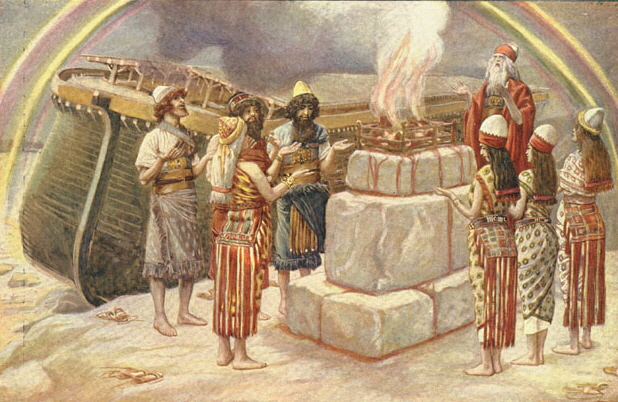 Rav Huna cited the report in that Noah offered burnt offerings from every clean animal and bird to support the proposition in a Baraita that all animals were eligible to be offered, as the words "animal" (, ''behemah'') and "bird" (, ''of'') refer to any animal or bird, and the term "animal" (, ''behemah'') includes wild beasts (, ''hayyah'').
Rav Huna cited the report in that Noah offered burnt offerings from every clean animal and bird to support the proposition in a Baraita that all animals were eligible to be offered, as the words "animal" (, ''behemah'') and "bird" (, ''of'') refer to any animal or bird, and the term "animal" (, ''behemah'') includes wild beasts (, ''hayyah'').
 Rabbi Haninah cited the report of that "the Lord smelled the sweet savor; and ... said ... 'I will not again curse the ground any more for man's sake,'" for the proposition that those who allow themselves to be pacified when drinking wine possess some of the characteristics of the Creator.
Rav Awira (or some say Rabbi Joshua ben Levi) taught that the Evil Inclination (''yetzer hara'') has seven names. God called it "Evil" in , saying, "the imagination of man's heart is evil from his youth." Moses called it "the Uncircumcised" in , saying, "Circumcise therefore the foreskin of your heart." David called it "Unclean" in ; Solomon called it "the Enemy" in ; Isaiah called it "the Stumbling-Block" in ; Ezekiel called it "Stone" in ; and Joel (prophet), Joel called it "the Hidden One" in .
The Rabbis taught in a Baraita that the Evil Inclination is hard to bear, since even God its Creator called it evil, as in , God says, "the desire of man's heart is evil from his youth."
Rabbi Haninah cited the report of that "the Lord smelled the sweet savor; and ... said ... 'I will not again curse the ground any more for man's sake,'" for the proposition that those who allow themselves to be pacified when drinking wine possess some of the characteristics of the Creator.
Rav Awira (or some say Rabbi Joshua ben Levi) taught that the Evil Inclination (''yetzer hara'') has seven names. God called it "Evil" in , saying, "the imagination of man's heart is evil from his youth." Moses called it "the Uncircumcised" in , saying, "Circumcise therefore the foreskin of your heart." David called it "Unclean" in ; Solomon called it "the Enemy" in ; Isaiah called it "the Stumbling-Block" in ; Ezekiel called it "Stone" in ; and Joel (prophet), Joel called it "the Hidden One" in .
The Rabbis taught in a Baraita that the Evil Inclination is hard to bear, since even God its Creator called it evil, as in , God says, "the desire of man's heart is evil from his youth."

Genesis chapter 9
The Rabbis interpreted to set forth Seven Laws of Noah, seven Noahide laws binding on all people: (1) to set up courts of justice, (2) not to commit idolatry, (3) not to commit blasphemy, (4) not to commit sexual immorality, (5) not to commit bloodshed (see ), (6) not to commit robbery, and (7) not to eat flesh cut from a living animal (see ). Rabbi Hanina taught that they were also commanded not to consume blood from a living animal. Rabbi Leazar taught that they were also commanded not to cross-breed animals. Shimon bar Yochai, Rabbi Simeon taught that they were also commanded not to commit witchcraft. Rabbi Johanan taught that they were also commanded not to emasculate animals. And Rabbi Assi taught that the children of Noah were also prohibited to do anything stated in "There shall not be found among you any one that makes his son or his daughter to pass through the fire, one that uses divination, a soothsayer, or an enchanter, or a sorcerer, or a charmer, or one that consults a ghost or a familiar spirit, or a necromancer." The Tosefta instructed that Israelites should not tempt anyone to violate a Noahide law. Rabbi Shimon ben Eleazar deduced from that even a one-day-old child scares small animals, but said that the corpse of even the giant Og of Bashan would need to be guarded from weasels and rats. Rabbi Tanhum ben Hanilai compared the laws of kashrut to the case of a physician who went to visit two patients, one whom the physician judged would live, and the other whom the physician judged would die. To the one who would live, the physician gave orders about what to eat and what not to eat. On the other hand, the physician told the one who would die to eat whatever the patient wanted. Thus to the nations who were not destined for life in the World to Come, God said in , "Every moving thing that lives shall be food for you." But to Israel, whom God intended for life in the World to Come, God said in , "These are the living things which you may eat." The Gemara noted the paradox that mother's milk is kosher even though it is a product of the mother's blood, which, due to , is not kosher. In explanation, the Gemara quoted “Who can bring a pure thing out of an impure? Is it not the One?” For God can bring a pure thing, such as milk, out of an impure thing, such as blood. It was taught in a Baraita that Rabbi Eleazar interpreted the words of , "And surely your blood of your lives will I require," to mean that God will require retribution (in the Jewish eschatology, Afterlife) from those who shed their own blood (by committing suicide). Similarly, the Tosefta cited for the proposition that just as one is liable for injury done to another, so is one liable for injury done to one's self. And Rabbi Simeon ben Eleazar said in the name of Rabbi Hilpai ben Agra, which he said in the name of Rabbi Johanan ben Nuri, that if one pulled out one's own hair, tore one's own clothing, broke one's utensils, or scattered one's coins, in a fit of anger, it should be seen as if that person did an act of service for an idol. The Midrash also read , "And surely (, ''ve-ach'') your blood of your lives will I require," to include one who strangles one's self. But the Midrash taught that the principle of retribution for suicide did not apply to one in the plight of Saul (who committed suicide to save himself from the Philistines) or one like Shadrach, Meshach, and Abednego, Hananiah, Mishael, and Azariah (who risked their lives to sanctify God's name), as the word , ''ach'' implies a limitation on the general rule. Judah bar Ezekiel, Rav Judah read the words of , "And surely your blood of your lives will I require," to teach that even a single judge could try a non-Jew (under the seven Noahide laws, as "will I require" is stated in the singular). A Midrash read , "at the hand of every beast will I require it," to teach that when a murder is committed in secret, even if no one knows of it and a court cannot punish the murderer, still God will avenge the victim's blood. Rabbi Jacob bar Aha said in the name of Rav Assi that Abraham asked God whether God would wipe out Abraham's descendants as God had destroyed the generation of the Flood. Rabbi Jacob bar Aha said in the name of Rav Assi that Abraham's question in , "O Lord God, how shall I know that I shall inherit it?" was part of a larger dialogue. Abraham asked God if Abraham's descendants should sin before God, would God do to them as God did to the generation of the Flood (in ) and the generation of the Dispersion (in Genesis in ). God told Abraham that God would not. Abraham then asked God (as reported in ), "Let me know how I shall inherit it." God answered by instructing Abraham (as reported in ), "Take Me a heifer of three years old, and a she-goat of three years old" (which Abraham was to sacrifice to God). Abraham acknowledged to God that this means of atonement through sacrifice would hold good while a sacrificial shrine remained in being, but Abraham pressed God what would become of his descendants when the Temple would no longer exist. God replied that God had already long ago provided for Abraham's descendants in the Torah the order of the sacrifices, and whenever they read it, God would deem it as if they had offered them before God, and God would grant them pardon for all their iniquities. Rabbi Jacob bar Aha said in the name of Rav Assi that this demonstrated that were it not for the , ''Ma'amadot'', groups of lay Israelites who participated in worship as representatives of the public, then heaven and earth could not endure.
Rabbi Meir taught that while it was certain that God would never again flood the world with water (), God might bring a flood of fire and brimstone, as God brought upon Sodom and Gomorrah.
Rabbi Jacob bar Aha said in the name of Rav Assi that Abraham asked God whether God would wipe out Abraham's descendants as God had destroyed the generation of the Flood. Rabbi Jacob bar Aha said in the name of Rav Assi that Abraham's question in , "O Lord God, how shall I know that I shall inherit it?" was part of a larger dialogue. Abraham asked God if Abraham's descendants should sin before God, would God do to them as God did to the generation of the Flood (in ) and the generation of the Dispersion (in Genesis in ). God told Abraham that God would not. Abraham then asked God (as reported in ), "Let me know how I shall inherit it." God answered by instructing Abraham (as reported in ), "Take Me a heifer of three years old, and a she-goat of three years old" (which Abraham was to sacrifice to God). Abraham acknowledged to God that this means of atonement through sacrifice would hold good while a sacrificial shrine remained in being, but Abraham pressed God what would become of his descendants when the Temple would no longer exist. God replied that God had already long ago provided for Abraham's descendants in the Torah the order of the sacrifices, and whenever they read it, God would deem it as if they had offered them before God, and God would grant them pardon for all their iniquities. Rabbi Jacob bar Aha said in the name of Rav Assi that this demonstrated that were it not for the , ''Ma'amadot'', groups of lay Israelites who participated in worship as representatives of the public, then heaven and earth could not endure.
Rabbi Meir taught that while it was certain that God would never again flood the world with water (), God might bring a flood of fire and brimstone, as God brought upon Sodom and Gomorrah.
 The Mishnah taught that the rainbow (of ) was one of ten miraculous things that God created on the sixth day of creation at twilight on the eve of the Sabbath. Jose ben Halafta, Rabbi Jose and Rabbi Judah disagreed whether verses of remembrance referring to the rainbow () needed to be said together or individually.
The Mishnah taught that the rainbow (of ) was one of ten miraculous things that God created on the sixth day of creation at twilight on the eve of the Sabbath. Jose ben Halafta, Rabbi Jose and Rabbi Judah disagreed whether verses of remembrance referring to the rainbow () needed to be said together or individually.
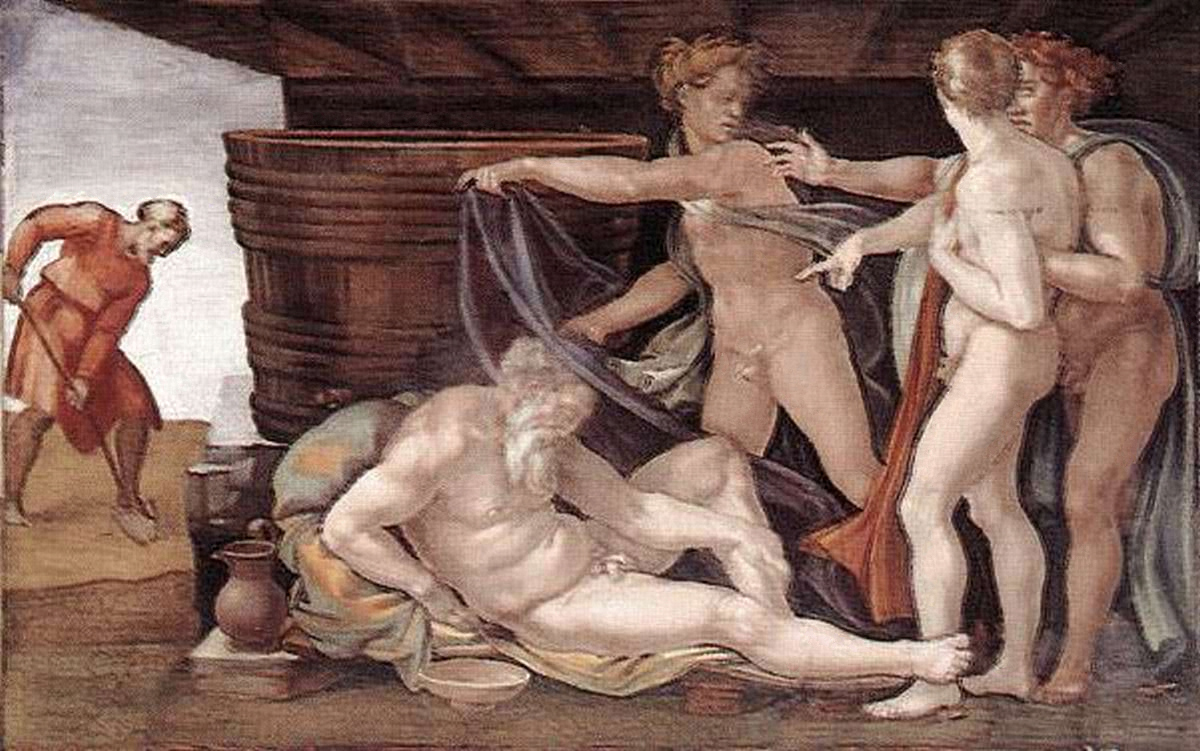 The Gemara helped explain why (as reports) God chose a rainbow as the symbol of God's promise. The Mishnah taught with regard to those who take no thought for the honor of their Maker, that it would have been better if they had not been born. Rabbi Abba read this Mishnah to refer to those who stare at a rainbow, while Rav Yosef b. Hiyya, Rav Joseph said that it refers to those who commit transgressions in secret. The Gemara explained that those who stare at a rainbow affront God's honor, as compares God's appearance to that of a rainbow: "As the appearance of the bow that is in the cloud in the day, so was the appearance of the brightness round about. This was the appearance of the likeness of the glory of the Lord." Thus those who stare at a rainbow behave as if they were staring directly at God. Similarly, Rabbi Judah ben Rabbi Nahmani, the speaker for Resh Lakish, taught that because compares God's appearance to that of a rainbow, staring at the rainbow harms one's eyesight.
The Gemara helped explain why (as reports) God chose a rainbow as the symbol of God's promise. The Mishnah taught with regard to those who take no thought for the honor of their Maker, that it would have been better if they had not been born. Rabbi Abba read this Mishnah to refer to those who stare at a rainbow, while Rav Yosef b. Hiyya, Rav Joseph said that it refers to those who commit transgressions in secret. The Gemara explained that those who stare at a rainbow affront God's honor, as compares God's appearance to that of a rainbow: "As the appearance of the bow that is in the cloud in the day, so was the appearance of the brightness round about. This was the appearance of the likeness of the glory of the Lord." Thus those who stare at a rainbow behave as if they were staring directly at God. Similarly, Rabbi Judah ben Rabbi Nahmani, the speaker for Resh Lakish, taught that because compares God's appearance to that of a rainbow, staring at the rainbow harms one's eyesight.
 The Talmud deduced two possible explanations (attributed to
The Talmud deduced two possible explanations (attributed to 
Genesis chapter 10
A
Genesis chapter 11
Rabbi Leazar in the name of Rabbi Jose bar Zimra found the story of the generation of the Dispersion (reported in ) reflected in the words of "Slay them not, lest my people forget, make them wander to and fro by Your power, and bring them down, O Lord, our Shield, for the sin of their mouth, and the words of their lips." Rabbi Leazar told in the name of Rabbi Jose bar Zimra that the people of Israel asked God: "Slay them [the generation of Dispersion] not, lest my people forget" and the generations that followed them forget. "Make them wander to and fro by Your power" — cast them away. "And bring them down" from the top of their tower to the land. But for us, said Israel, may "The Lord be our shield." "For the sin of their mouth" — for the sin that the generation of the Dispersion uttered when they said that once in every 1,656 years (the time from the Creation to the Flood), the Firmament disintegrates (thus not recognizing that God unleashed the Flood because of human evil). Therefore, they said, people should make supports for the Firmament, one in the north, one in the south, one in the west, and the Tower of Babel in the east. "And the word of their lips" reflects that they said this to each other by virtue of the "one language" that reports that they had. The Tosefta taught that the men of the Tower of Babel acted arrogantly before God only because God had been so good to them (in ) as to give them a single language and allow them to settle in Shinar. And as usage elsewhere indicated that "settle" meant "eat and drink" (see ), this eating and drinking was what led them to say (in ) that they wanted to build the Tower.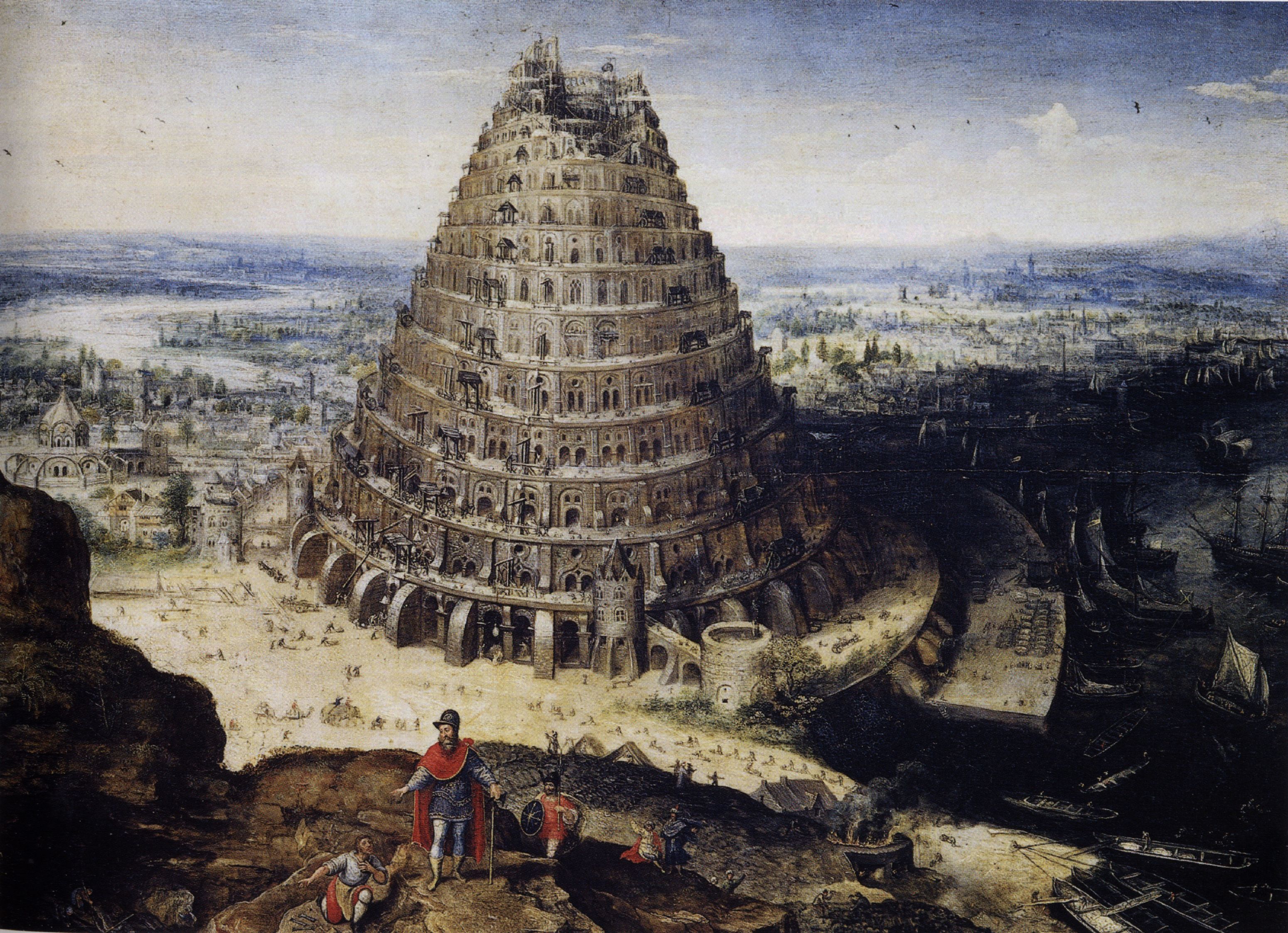 Rabbi Levi, or some say Rabbi Jonathan, said that a tradition handed down from the Men of the Great Assembly taught that wherever the Bible employs the term "and it was" or "and it came to pass" (, ''wa-yehi''), as it does in , it indicates misfortune, as one can read ''wa-yehi'' as ''wai'', ''hi'', "woe, sorrow." Thus the words, "And it came to pass," in are followed by the words, "Come, let us build us a city," in . And the Gemara also cited the instances of followed by ; followed by ; followed by the rest of ; followed by ; followed by ; followed by ; close after ; followed by ; followed by the rest of ; and followed by Haman (Bible), Haman. But the Gemara also cited as counterexamples the words, "And there was evening and there was morning one day," in , as well as , and . So Rav Ashi replied that ''wa-yehi'' sometimes presages misfortune, and sometimes it does not, but the expression "and it came to pass in the days of" always presages misfortune. And for that proposition, the Gemara cited , , , and .
Rabbi Levi, or some say Rabbi Jonathan, said that a tradition handed down from the Men of the Great Assembly taught that wherever the Bible employs the term "and it was" or "and it came to pass" (, ''wa-yehi''), as it does in , it indicates misfortune, as one can read ''wa-yehi'' as ''wai'', ''hi'', "woe, sorrow." Thus the words, "And it came to pass," in are followed by the words, "Come, let us build us a city," in . And the Gemara also cited the instances of followed by ; followed by ; followed by the rest of ; followed by ; followed by ; followed by ; close after ; followed by ; followed by the rest of ; and followed by Haman (Bible), Haman. But the Gemara also cited as counterexamples the words, "And there was evening and there was morning one day," in , as well as , and . So Rav Ashi replied that ''wa-yehi'' sometimes presages misfortune, and sometimes it does not, but the expression "and it came to pass in the days of" always presages misfortune. And for that proposition, the Gemara cited , , , and .
 Rabbi Johanan said in the name of Rabbi Eleazar the son of Rabbi Simeon that wherever you find the words of Rabbi Eleazar the son of Rabbi Jose the Galilean in an Aggadah, make your ear like a funnel (to receive the teaching). (Rabbi Eleazar taught that) God bestowed greatness on Nimrod, but Nimrod (did not humble himself, but) said, in the words of , "Come, let us build ourselves a city."
The Mishnah taught that the generation of the dispersion has no portion in the world to come. The Gemara asked what they did to justify this punishment. The scholars of the academy of Rav Shila taught that they sought to build a tower, ascend to heaven, and cleave it with axes, that its waters might gush forth. In the academies of the Land of Israel, they laughed at this, arguing that if the generation of the dispersion had sought to do so, they should have built the tower on a mountain. Rabbi Jeremiah bar Eleazar taught that the generation of the dispersion split into three parties. One party sought to ascend to heaven and dwell there. The second party sought to ascend to heaven and serve idols. And the third party sought to ascend and wage war with God. God scattered the party that proposed to ascend and dwell there. God turned into apes, spirits, devils, and night-demons the party that sought to ascend and wage war with God. As for the party that sought to ascend and serve idols, God responded, in the words of , "for there the Lord did confound the language of all the earth." It was taught in a Baraita that Nathan the Babylonian, Rabbi Nathan said that the generation of the dispersion were all bent on idolatry. For says, "let us make us a name," while says, "and make no mention of the name of other gods." Rabbi Nathan reasoned that just as the word "name" indicates idolatry in , so does the word "name" in . Rabbi Jonathan taught that a third of the tower was burned, a third sank into the earth, and a third still stood at his time. Rav taught that the atmosphere of the tower caused forgetfulness. Rav Joseph taught that Babylon and the neighboring city of Borsif were both evil omens for the Torah, because one soon forgets one's learning there. Rabbi Assi said that the name "Borsif" means "an empty pit" (''bor shafi''), for it empties one of knowledge.
Rabbi Johanan said in the name of Rabbi Eleazar the son of Rabbi Simeon that wherever you find the words of Rabbi Eleazar the son of Rabbi Jose the Galilean in an Aggadah, make your ear like a funnel (to receive the teaching). (Rabbi Eleazar taught that) God bestowed greatness on Nimrod, but Nimrod (did not humble himself, but) said, in the words of , "Come, let us build ourselves a city."
The Mishnah taught that the generation of the dispersion has no portion in the world to come. The Gemara asked what they did to justify this punishment. The scholars of the academy of Rav Shila taught that they sought to build a tower, ascend to heaven, and cleave it with axes, that its waters might gush forth. In the academies of the Land of Israel, they laughed at this, arguing that if the generation of the dispersion had sought to do so, they should have built the tower on a mountain. Rabbi Jeremiah bar Eleazar taught that the generation of the dispersion split into three parties. One party sought to ascend to heaven and dwell there. The second party sought to ascend to heaven and serve idols. And the third party sought to ascend and wage war with God. God scattered the party that proposed to ascend and dwell there. God turned into apes, spirits, devils, and night-demons the party that sought to ascend and wage war with God. As for the party that sought to ascend and serve idols, God responded, in the words of , "for there the Lord did confound the language of all the earth." It was taught in a Baraita that Nathan the Babylonian, Rabbi Nathan said that the generation of the dispersion were all bent on idolatry. For says, "let us make us a name," while says, "and make no mention of the name of other gods." Rabbi Nathan reasoned that just as the word "name" indicates idolatry in , so does the word "name" in . Rabbi Jonathan taught that a third of the tower was burned, a third sank into the earth, and a third still stood at his time. Rav taught that the atmosphere of the tower caused forgetfulness. Rav Joseph taught that Babylon and the neighboring city of Borsif were both evil omens for the Torah, because one soon forgets one's learning there. Rabbi Assi said that the name "Borsif" means "an empty pit" (''bor shafi''), for it empties one of knowledge.
 Rabbi Phineas taught that the land of Babel had no stones with which to build the city and the tower. So they baked bricks until they built the tower seven miles high. The tower had ramps on its east and its west. Laborers took up the bricks on the eastern ramp, and people descended on the western ramp. If a man fell and died, the laborers paid him no heed, but if a brick fell, they sat and wept, asking when another brick would come in its stead.
Rabbi Simeon bar Yohai taught that the report of that "the Lord came down to see the city and the tower" was one of ten instances when the Torah reports that God descended.
Rabbi Phineas taught that the land of Babel had no stones with which to build the city and the tower. So they baked bricks until they built the tower seven miles high. The tower had ramps on its east and its west. Laborers took up the bricks on the eastern ramp, and people descended on the western ramp. If a man fell and died, the laborers paid him no heed, but if a brick fell, they sat and wept, asking when another brick would come in its stead.
Rabbi Simeon bar Yohai taught that the report of that "the Lord came down to see the city and the tower" was one of ten instances when the Torah reports that God descended.
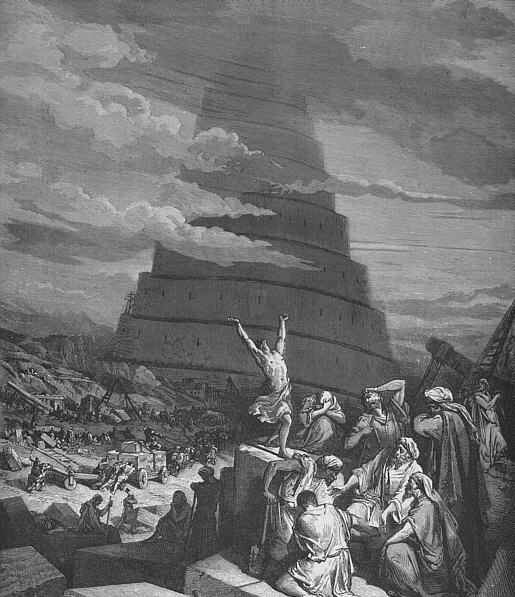 Rabbi Judah and Rabbi Nehemiah disagreed over how to interpret , “And the Lord said: ‘Behold, they are one people, and they have all one language; and this is what they begin to do; and now nothing will be withheld from them, which they purpose to do.’” Rabbi Judah interpreted the words, “Behold, they are one people, and they have all one language,” to mean that because the people lived in unity, if they had repented, God would have accepted them. But Rabbi Nehemiah explained that it was because “they are one people, and they have all one language,” that they rebelled against God. Rabbi Abba bar Kahana taught that God gave them an opportunity to repent, for the words “and now” in indicate repentance, for says, “''And now'', Israel, what does the Lord your God require of you, but to fear the Lord your God.” But the next word of , “No,” reports their response. The continuation of , then reports God's reply, “Then let all that they purpose to do be withheld from them!”
Rabbi Johanan taught that wherever heretics have taken Biblical passages as grounds for their heresy, another passage nearby provides the refutation. Thus (the heretics questioned the use of the plural with regard to God in ): "Come, let us go down and there confound their language." (But nearby, in , it says in the singular): "And the Lord came down to see the city and the tower." Rabbi Johanan taught that God says, "let us," in the plural in (and elsewhere) to show that God does nothing without first consulting God's Heavenly Court.
Rabbi Simeon told that God called to the 70 angels who surround the throne of God's glory and said, "Let us descend and let us confuse the 70 nations (that made up the world) and the 70 languages." Rabbi Simeon deduced this from , where God said, "Let ''us'' go down," not "''I'' will go down." Rabbi Simeon taught that , "When the Most High gave to the nations their inheritance," reports that they cast lots among them. God's lot fell upon Abraham and his descendants, as reports, "For the Lord's portion is his people; Jacob is the lot of his inheritance." God said that God's soul lives by the portion and lot that fell to God, as says, "The lots have fallen to me in pleasures; yea, I have a goodly heritage." God then descended with the 70 angels who surround the throne of God's glory and they confused the speech of humankind into 70 nations and 70 languages.
Rabbi Judah and Rabbi Nehemiah disagreed over how to interpret , “And the Lord said: ‘Behold, they are one people, and they have all one language; and this is what they begin to do; and now nothing will be withheld from them, which they purpose to do.’” Rabbi Judah interpreted the words, “Behold, they are one people, and they have all one language,” to mean that because the people lived in unity, if they had repented, God would have accepted them. But Rabbi Nehemiah explained that it was because “they are one people, and they have all one language,” that they rebelled against God. Rabbi Abba bar Kahana taught that God gave them an opportunity to repent, for the words “and now” in indicate repentance, for says, “''And now'', Israel, what does the Lord your God require of you, but to fear the Lord your God.” But the next word of , “No,” reports their response. The continuation of , then reports God's reply, “Then let all that they purpose to do be withheld from them!”
Rabbi Johanan taught that wherever heretics have taken Biblical passages as grounds for their heresy, another passage nearby provides the refutation. Thus (the heretics questioned the use of the plural with regard to God in ): "Come, let us go down and there confound their language." (But nearby, in , it says in the singular): "And the Lord came down to see the city and the tower." Rabbi Johanan taught that God says, "let us," in the plural in (and elsewhere) to show that God does nothing without first consulting God's Heavenly Court.
Rabbi Simeon told that God called to the 70 angels who surround the throne of God's glory and said, "Let us descend and let us confuse the 70 nations (that made up the world) and the 70 languages." Rabbi Simeon deduced this from , where God said, "Let ''us'' go down," not "''I'' will go down." Rabbi Simeon taught that , "When the Most High gave to the nations their inheritance," reports that they cast lots among them. God's lot fell upon Abraham and his descendants, as reports, "For the Lord's portion is his people; Jacob is the lot of his inheritance." God said that God's soul lives by the portion and lot that fell to God, as says, "The lots have fallen to me in pleasures; yea, I have a goodly heritage." God then descended with the 70 angels who surround the throne of God's glory and they confused the speech of humankind into 70 nations and 70 languages.
 The Sages taught that the God who punished the generation of the Flood and the generation of the Dispersion would take vengeance on people who renege on their word after money has been paid.
The Gemara asked what the name Babel (which can mean "to mix" or "confound," as in ) connotes. Rabbi Johanan answered that the study of Scripture, Mishnah, and Talmud was intermingled (in the study reported in the Babylonian Talmud).
The Mishnah observed that there were ten generations from Adam to Noah (enumerated in ), to make known God’s long-suffering; for all those generations kept on provoking God, until God brought upon them the waters of the Flood. And there were also ten generations from Noah to Abraham (enumerated in ), to make known God’s long-suffering; for all those generations kept on provoking God, until Abraham came and received the reward of all of them.
The Sages taught that the God who punished the generation of the Flood and the generation of the Dispersion would take vengeance on people who renege on their word after money has been paid.
The Gemara asked what the name Babel (which can mean "to mix" or "confound," as in ) connotes. Rabbi Johanan answered that the study of Scripture, Mishnah, and Talmud was intermingled (in the study reported in the Babylonian Talmud).
The Mishnah observed that there were ten generations from Adam to Noah (enumerated in ), to make known God’s long-suffering; for all those generations kept on provoking God, until God brought upon them the waters of the Flood. And there were also ten generations from Noah to Abraham (enumerated in ), to make known God’s long-suffering; for all those generations kept on provoking God, until Abraham came and received the reward of all of them.
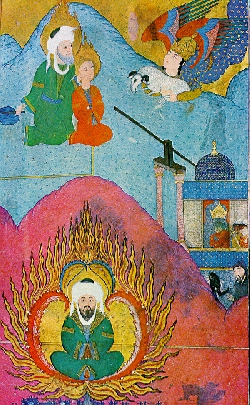 The Mishnah taught that Abraham suffered ten trials and withstood them all, demonstrating how great Abraham's love was for God.Mishnah Avot 5:3
The Mishnah taught that Abraham suffered ten trials and withstood them all, demonstrating how great Abraham's love was for God.Mishnah Avot 5:3in, e.g., Jacob Neusner, translator, ''Mishnah'', page 685. The Avot of Rabbi Natan taught that two trials were at the time he was bidden to leave Haran, two were with his two sons, two were with his two wives, one was in the wars of the Kings, one was at the covenant between the pieces, one was in Ur of the Chaldees (where, according to a tradition, he was thrown into a furnace and came out unharmed), and one was the covenant of circumcision. Similarly, the Pirke De-Rabbi Eliezer counted as the 10 trials (1) when Abraham was a child and all the magnates of the kingdom and the magicians sought to kill him (see below), (2) when he was put into prison for ten years and cast into the furnace of fire, (3) his migration from his father's house and from the land of his birth, (4) the famine, (5) when Sarah his wife was taken to be Pharaoh's wife, (6) when the kings came against him to slay him, (7) when (in the words of ) "the word of the Lord came to Abram in a vision," (8) when Abram was 99 years old and God asked him to circumcise himself, (9) when Sarah asked Abraham (in the words of ) to "Cast out this bondwoman and her son," and (10) the binding of Isaac. The Pirke De-Rabbi Eliezer taught that the first trial was when Abram was born, and all the magnates of the kingdom and the magicians sought to kill him. Abram's family hid Abram in a cave for 13 years without seeing the sun or moon. After 13 years, Abram came out speaking the holy language, Hebrew, and he despised idols and held in abomination the graven images, and he trusted in God, saying (in the words of ): "Blessed is the man who trusts in You." In the second trial, Abram was put in prison for ten years — three years in Kuthi, seven years in Budri. After ten years, they brought him out and cast him into the furnace of fire, and God delivered him from the furnace of fire, as says, "And He said to him, 'I am the Lord who brought you out of the furnace of the Chaldees." Similarly, reports, "You are the Lord the God, who did choose Abram, and brought him forth out of the furnace of the Chaldees." The third trial was Abram's migration from his father's house and from the land of his birth. God brought him to Haran, and there his father Terah died, and Athrai his mother. The Pirke De-Rabbi Eliezer taught that migration is harder for a human than for any other creature. And tells of his migration when it says, "Now the Lord said to Abram, 'Get out.'" The Gemara taught that Sarah was one of seven prophetesses who prophesied to Israel and neither took away from nor added anything to what is written in the Torah. (The other prophetesses were Miriam, Deborah, Hannah (Bible), Hannah, Abigail, Huldah, and Esther.) The Gemara derived Sarah's status as a prophetess from the words, "Haran, the father of Milkah and the father of Yiscah," in . Rabbi Isaac taught that Yiscah was Sarah. called her Yiscah () because she discerned (''saketah'') by means of Divine inspiration, as reports God instructing Abraham, "In all that Sarah says to you, hearken to her voice." Alternatively, called her Yiscah because all gazed (''sakin'') at her beauty. The Pesikta de-Rav Kahana taught that Sarah was one of seven barren women about whom says (speaking of God), "He ... makes the barren woman to dwell in her house as a joyful mother of children." The Pesikta de-Rav Kahana also listed Rebecca, Rebekah Rachel,
In medieval Jewish interpretation
The parashah is discussed in these Middle Ages, medieval Jewish sources:Genesis chapter 6
Bahya ibn Paquda, Baḥya ibn Paquda read the description "perfect" (, ''tamim'') in to describe one who aims to make one's exterior and interior selves equal and consistent in the service of God, so that the testimony of the heart, tongue, and limbs are alike and support and confirm each other. Maimonides taught that God, being incorporeal, is elevated above the use of a sense of sight. Thus, when Scripture says that God "sees" — as in , "And God ''saw'' the earth, and, behold, it was corrupt" — it means that God perceives visible things. Maimonides thus argued that "God
saw" would be more properly translated "it was revealed before God."
Maimonides taught that whenever Scripture relates that God spoke to a person, this took place in a dream or in a prophetic vision.
Thus , "And God said to Noah," reports a prophecy proclaimed by Noah acting as a prophet.
Maimonides taught that God, being incorporeal, is elevated above the use of a sense of sight. Thus, when Scripture says that God "sees" — as in , "And God ''saw'' the earth, and, behold, it was corrupt" — it means that God perceives visible things. Maimonides thus argued that "God
saw" would be more properly translated "it was revealed before God."
Maimonides taught that whenever Scripture relates that God spoke to a person, this took place in a dream or in a prophetic vision.
Thus , "And God said to Noah," reports a prophecy proclaimed by Noah acting as a prophet.
 Abraham ibn Ezra wrote that , "But I will establish My covenant," could be read to indicate that God had sworn earlier to Noah that he and his children would not die in the Flood, even though the text had not previously mentioned it. Alternatively, ibn Ezra taught that "But I will establish" meant that God would keep God's oath. Ibn Ezra also taught that the "covenant" alluded to the covenant that God would make when God set the rainbow in the sky in . After reviewing Ibn Ezra's analysis, Nahmanides, Nachmanides argued that the expression, "And I will establish My covenant," meant that when the Flood came, God's covenant would be established with Noah so that he and his family and two of all the animals would come into the Ark and remain alive, and "covenant" meant God's word when God decrees something without any condition and fulfills it. Nachmanides also taught that by way of the Kabbalah, the covenant (, ''berit'') is everlasting, the word being derived from , "In the beginning God created (, ''bara'')." God thus commanded that the covenant exist and be with the righteous Noah.
Maimonides taught that before Abraham's birth, only a very few people recognized or knew God in the world, among them Enoch (ancestor of Noah), Enoch, Methuselah, Noah, Shem, and Eber.
Abraham ibn Ezra wrote that , "But I will establish My covenant," could be read to indicate that God had sworn earlier to Noah that he and his children would not die in the Flood, even though the text had not previously mentioned it. Alternatively, ibn Ezra taught that "But I will establish" meant that God would keep God's oath. Ibn Ezra also taught that the "covenant" alluded to the covenant that God would make when God set the rainbow in the sky in . After reviewing Ibn Ezra's analysis, Nahmanides, Nachmanides argued that the expression, "And I will establish My covenant," meant that when the Flood came, God's covenant would be established with Noah so that he and his family and two of all the animals would come into the Ark and remain alive, and "covenant" meant God's word when God decrees something without any condition and fulfills it. Nachmanides also taught that by way of the Kabbalah, the covenant (, ''berit'') is everlasting, the word being derived from , "In the beginning God created (, ''bara'')." God thus commanded that the covenant exist and be with the righteous Noah.
Maimonides taught that before Abraham's birth, only a very few people recognized or knew God in the world, among them Enoch (ancestor of Noah), Enoch, Methuselah, Noah, Shem, and Eber.
 The ''Zohar'' compared Moses to Noah and found Moses superior. For when God told Moses in , “Now therefore let me alone, that My anger may grow hot against them, and that I may consume them; and I will make of you a great nation,” Moses immediately asked whether he could possibly abandon Israel for his own advantage. Moses protested that the world would say that he had killed Israel and did to them as Noah did to his generation. For when God bade Noah to save himself and his household from the Flood, Noah did not intercede on behalf of his generation, but let them perish. It is for this reason that Scripture names the waters of the Flood after Noah, as says, “For this is as the waters of Noah to me.” Thus, Moses sought mercy for his people, and God indeed showed them mercy.
The ''Zohar'' compared Moses to Noah and found Moses superior. For when God told Moses in , “Now therefore let me alone, that My anger may grow hot against them, and that I may consume them; and I will make of you a great nation,” Moses immediately asked whether he could possibly abandon Israel for his own advantage. Moses protested that the world would say that he had killed Israel and did to them as Noah did to his generation. For when God bade Noah to save himself and his household from the Flood, Noah did not intercede on behalf of his generation, but let them perish. It is for this reason that Scripture names the waters of the Flood after Noah, as says, “For this is as the waters of Noah to me.” Thus, Moses sought mercy for his people, and God indeed showed them mercy.
Genesis chapter 7
Maimonides taught that although the two Hebrew nouns , ''ish'', and , ''ishah'', were originally employed to designate the "male" and "female" of human beings, they were afterwards applied to the "male" and "female" of other species of the animal creation. Thus, in , "Of every clean beast you shall take seven and seven, each with his mate (, ''ish ve-ishto'')," the words , ''ish ve-ishto'' mean "male and female" of those animals. ''The Zohar'' teaches that the waters did not touch the Land of Israel, that is, Jerusalem.Genesis chapter 8
Reading , “And God ''remembered'' Noah,” Saadia Gaon taught that Scripture designates the deliverance of the human world from a painful situation as a ''recollection'' on the part of God. Saadia argued that the verse does not permit the use of the term “forgetfulness” in connection with God's desisting from delivering God's creatures. The ''Midrash ha-Ne'lam (The Midrash of the Concealed)'' told that when Noah left the Ark and saw the terrible destruction all around, he wept and cried out to God that God should have shown compassion for God's creatures. God called Noah a foolish shepherd and asked why Noah complained only then, and not when God told Noah in , “You have I seen righteous before Me in this generation”; or when in , God told Noah, “And I, behold, I do bring the flood of waters upon the earth, to destroy all flesh”; or when in , God told Noah, “Make an ark of gopher wood.” God told Noah those things so that Noah would seek compassion for the world. But as soon as Noah heard that he would be saved in the Ark, the evil of the world did not touch his heart. Noah built the Ark and saved himself! Now that the world had been destroyed, Noah opened his mouth before God with prayers and supplications! When Noah realized his mistake, he offered sacrifices, as says, “And Noah built an altar to the Lord; and took of every clean beast, and of every clean fowl, and offered burnt-offerings on the altar.” Similarly, the ''Midrash ha-Ne'lam'' contrasted Noah with the righteous heroes who arose for Israel afterward. Noah did not shield his generation and did not pray for them as Abraham did for his. For as soon as God told Abraham in , “the cry of Sodom and Gomorrah is great,” immediately in , “Abraham drew near, and said.” Abraham countered God with more and more words until he implored that if just ten righteous people were found there, God would grant atonement to the generation for their sake. Abraham thought that there were ten in the city, counting Lot and his wife, his daughters and sons-in-law, and that is why he beseeched no further. Baḥya ibn Paquda noted that , "God said in His heart," and , "for God made man in His image," imply that God has physical form and body parts. And , "and God remembered"; , "and God smelled the pleasing aroma"; , "and God came down," imply that God moves and takes bodily actions like human beings. Baḥya explained that necessity brought people to anthropomorphize God and describe God in terms of human attributes so that human listeners could grasp God in their minds. After doing so, people can learn that such description was only metaphorical, and that the truth is too fine, too sublime, too exalted, and too remote from the ability and powers of human minds to grasp. Baḥya advised wise thinkers to endeavor to remove the husk of the terms and their corporeality and ascend in their minds step by step to reach the true intended meaning according to the power and ability of their minds to grasp. Baḥya cautioned that one must be careful not to take descriptions of God's attributes literally or in a physical sense. Rather, one must know that they are metaphors, geared to what we are capable of grasping with our powers of understanding, because of our urgent need to know God. But God is infinitely greater and loftier than all of these attributes. Maimonides read to refer to the evil inclination (''yetzer ha-ra''). Maimonides taught that the three terms — the adversary (, ''ha-satan''), the evil inclination (''yetzer ha-ra''), and the angel of death — all designate the same thing. And actions ascribed to these three are in reality the actions of one and the same agent. Maimonides taught that the Hebrew term , ''satan'' was derived from the same root as the word , ''seteh'', "turn away," as in , and thus implies the notion of turning and moving away from a thing. Thus, the adversary turns people away from the way of truth, and leads them astray in the way of error. Maimonides taught that the same idea is contained in , "And the imagination of the heart of man is evil from his youth." Maimonides reported that the Sages also said that people receive the evil inclination at birth, for says, "at the door sin crouches," and says, "And the imagination of the heart of man is evil from his youth." The good inclination, however, is developed. Maimonides taught that the Sages refer to the evil inclination and the good inclination when they tell that every person is accompanied by two angels, one on the right side and one on the left, one good and one bad.Genesis chapter 9
Baḥya ibn Paquda argued that one proof in creation of God's existence is that out of God's abounding goodness to mankind, God put the fear of humans into dangerous wild creatures, as says, "And the fear of you and the dread of you shall be upon every beast of the earth." Saadia Gaon read , "Whoso sheds man's blood, ''by man'' shall his blood be shed," to explain why the death penalty was not imposed on Cain for killing Abel, for at the time of that murder, neither judge or witnesses yet existed to impose the penalty.Genesis chapter 11
Maimonides taught that when Scripture reports that God intended "to descend," it signals that God meant to punish humanity, as in , "And the Lord came down to see"; , "Let us go down and there confound their language"; and , "I will go down now and see."Genesis chapters 11–22
In their commentaries tMishnah Avot 5:3
ref name=Avot5:3 /> (see "In classical rabbinic interpretation" above), Rashi and Maimonides differed on what 10 trials Abraham faced:
In modern interpretation
The parashah is discussed in these modern sources:Genesis chapters 5–11
Victor P. Hamilton observed that genealogies bracket narrative blocks in the opening chapters of Genesis. :1A: genealogy (Noah's sons) ::1B: narrative (the sons of God) :1A1: genealogy (Noah's sons) :2A: genealogy (Noah's sons) ::2B: narrative (the Flood) :2A1: genealogy (Noah's sons) :3A: genealogy (Shemites) ::3B: narrative (Tower of Babel) :3A1: genealogy (Shemites) Hamilton argued that this literary artistry provides another reason for the sequence of chapters and .Genesis chapter 6
Ephraim Avigdor Speiser, Ephraim Speiser contrasted the reason for the Flood given by the Jahwist in — that God “regretted” with “sorrow in His heart” that man had not been able to master his evil impulses — with the reason given by the Priestly source in — that the world was lawless and thus had to be destroyed.Ephraim A. Speiser. ''Genesis: Introduction, Translation, and Notes'', volume 1, page xxix. New York: Anchor Bible Series, Anchor Bible, 1964. Although the text does not name Noah's wife when it mentions her in ;13
and , Carol Meyers reported that postbiblical discussions of the Genesis Flood story assigned her more than 103 different names.
Genesis chapter 7
Speiser read12
an
to reflect the Jahwist's chronology that the rains came down 40 days and nights, and the waters disappeared after 3 times 7 days, the whole deluge lasting thus 61 days. Whereas Speiser read the Priestly source, whose calendar is typically detailed down to the exact day of the given month, to report in that the waters held their crest for 150 days and to report in and that they remained on the earth one year and 11 days.
Genesis chapter 8
Walter Brueggemann wrote that God's promise in inverts the destructive action of the Flood story and marks the decisive end of the Genesis pre-history.Genesis chapter 9
Moses Mendelssohn alluded to , "in the image of God made He man," in comparing church and state. Government and religion, Mendelssohn asserted, have for their object the promotion, by means of public measures, of human felicity in this life and in the life to come. Both act upon people's convictions and actions, on principles and their application; the state, by means of reasons based on the relations between people, or between people and nature, and religion by means of reasons based on the relations between people and God. The state treats people as the immortal children of the earth; religion treats people as the image of their Creator.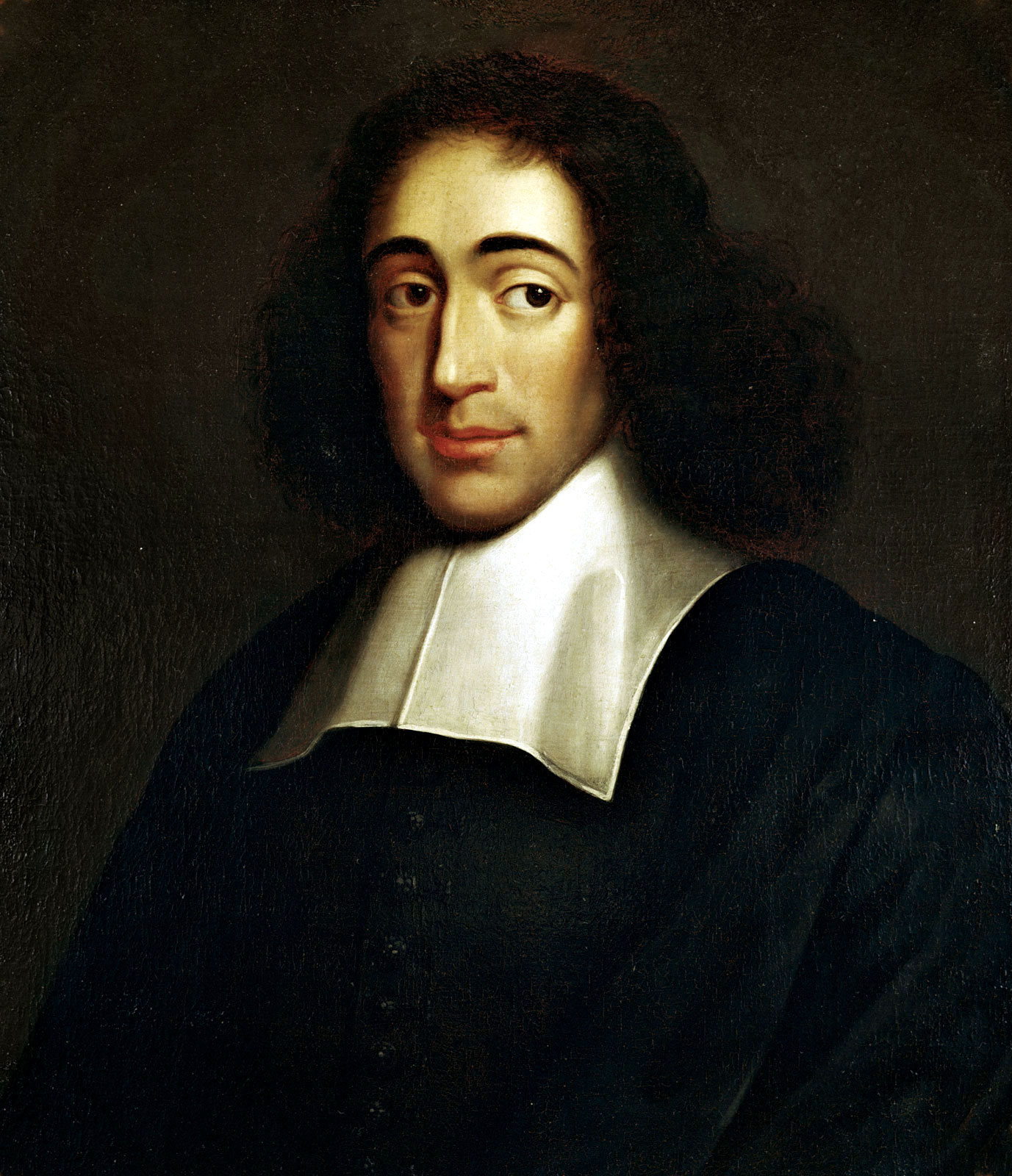 Baruch Spinoza explained the report of , in which God told Noah that God would set God's rainbow in the cloud, as but another way of expressing the refraction and reflection that the rays of the sun are subjected to in drops of water. Spinoza concluded that God's decrees and mandates, and consequently God's Providence, are merely the order of nature, and when Scripture describes an event as accomplished by God or God's will, we must understand merely that it was in accordance with the law and order of nature, not that nature had for a time ceased to act, or that nature's order was temporarily interrupted.
Baruch Spinoza explained the report of , in which God told Noah that God would set God's rainbow in the cloud, as but another way of expressing the refraction and reflection that the rays of the sun are subjected to in drops of water. Spinoza concluded that God's decrees and mandates, and consequently God's Providence, are merely the order of nature, and when Scripture describes an event as accomplished by God or God's will, we must understand merely that it was in accordance with the law and order of nature, not that nature had for a time ceased to act, or that nature's order was temporarily interrupted.
Genesis chapter 10
Spinoza noted that Abraham ibn Ezra alluded to a difficulty by noting that if, as indicates, Canaan first settled the land, then the Canaanites still possessed those territories during the time of Moses. Spinoza deduced that the person who wrote , "the Canaanite was then in the land," must thus have written at a time when the Canaanites had been driven out and no longer possessed the land, and thus after the death of Moses. Spinoza concluded that Moses did not write the Torah, but someone who lived long after him, and that the book that Moses wrote was something different from any now extant.Genesis chapter 11
Brueggemann argued that was as Chiasmus, symmetrically structured as any narrative since , showing the conflict of human resolve with God's resolve: :A: "Whole earth ... one language" ::B: Human words and actions :::C: "Come let us" ::B1: God's words and actions :::C1: "Come let us" :A1: "The language of all the earth ... all the earth" Umberto Cassuto suggested that the Tower of Babel story in reflects an earlier Israelite poem that regarded with a smile the boastful pride of the Babylonians in their city, temple, and ziggurat. Cassuto deduced that Israelites composed the poem when the city and tower were already in ruins, and he posited that they were written in the centuries after the fall of the First Babylonian dynasty and the destruction of Babylon by the Biblical Hittites, Hittites in the middle of the 16th century B.C.E., during which Israelites remembered the bragging of the Babylonians with derision. Cassuto saw manifest irony in the report of , "And they had brick for stone," as if the Israelites mocked the object of Babylonian boasting — buildings of bricks, which stand today and tomorrow are in ruins — as if the poor Babylonians did not even have hard stone for building such as the Israelites had in the land of Israel. Similarly, the liberal Germany, German Rabbi and scholar Benno Jacob, writing in 1934, saw irony in the report of , "And the Lord came down," which implied that the tower supposed to reach to the heavens was still far from there, and that seen from above, the gigantic structure was only the work of "children," of miniature men.
Umberto Cassuto suggested that the Tower of Babel story in reflects an earlier Israelite poem that regarded with a smile the boastful pride of the Babylonians in their city, temple, and ziggurat. Cassuto deduced that Israelites composed the poem when the city and tower were already in ruins, and he posited that they were written in the centuries after the fall of the First Babylonian dynasty and the destruction of Babylon by the Biblical Hittites, Hittites in the middle of the 16th century B.C.E., during which Israelites remembered the bragging of the Babylonians with derision. Cassuto saw manifest irony in the report of , "And they had brick for stone," as if the Israelites mocked the object of Babylonian boasting — buildings of bricks, which stand today and tomorrow are in ruins — as if the poor Babylonians did not even have hard stone for building such as the Israelites had in the land of Israel. Similarly, the liberal Germany, German Rabbi and scholar Benno Jacob, writing in 1934, saw irony in the report of , "And the Lord came down," which implied that the tower supposed to reach to the heavens was still far from there, and that seen from above, the gigantic structure was only the work of "children," of miniature men.
In critical analysis
7
an
And he attributes to the Priestly source ;
an
For a similar distribution of verses, see v:Bible, English, King James, Documentary Hypothesis, Genesis, the display of Genesis according to the Documentary Hypothesis at Wikiversity. Friedman also attributes to a late Redactor (sometimes abbreviated R) the introductory clause in and to another source the report of Noah's age during the Flood in . Friedman also attributes to the Jahwist the account of Noah's drunkenness and the cursing of Canaan in ; the genealogies in
21
an
and the story of the Tower of Babel in . He attributes to the Priestly source the account of the covenant of the rainbow in and the genealogies in
and . He attributes to the Redactor introductory clauses in ; an
and the account of Terah in an
And he attributes to another source the genealogy of Shem at an
Gary Rendsburg, however, notes that the Flood story has many similarities with the Epic of Gilgamesh. He argues that several sources would be unlikely to track these plot elements from the Epic of Gilgamesh independently. Thus, Rendsburg argues that the Flood story was composed as a unified whole.
Commandments
Maimonides cited the parashah for one positive Mitzvah, commandment: *To "be fruitful and multiply" The ''Sefer ha-Chinuch'', however, attributed the commandment to . The ''Kitzur Shulchan Aruch'' read the words of , "And surely your blood of your lives will I require," to refer to "foolish pietists" who needlessly endanger their lives by refusing to be healed on the Sabbath. The ''Kitzur Shulchan Aruch'' taught that one overrides the Shabbat as well as other commandments (except for idol worship, incest, and murder) if there is danger to life and one who hastens to disregard the Sabbath for an ill person who is in danger is praiseworthy.
Similarly, the ''Kitzur Shulchan Aruch'' read the words of , "And surely your blood of your lives will I require," to support the proposition that one who commits suicide is considered an evildoer of the highest degree. For God created the world for a single individual, Adam, so anyone who destroys a soul destroys a whole world. The ''Kitzur Shulchan Aruch'' therefore taught that Jews should not carry out for one who committed suicide anything to honor that person, but Jews should bury the body after cleansing and dressing it in a shroud. The principle is that everything for honoring the living relatives should be done for them, as opposed to for the honor of the person who committed suicide.
The ''Kitzur Shulchan Aruch'' taught that upon arising in the morning, one should wash one's face in honor of one's Creator, as states, "for in the image of God made He man."
The ''Kitzur Shulchan Aruch'' read the words of , "And surely your blood of your lives will I require," to refer to "foolish pietists" who needlessly endanger their lives by refusing to be healed on the Sabbath. The ''Kitzur Shulchan Aruch'' taught that one overrides the Shabbat as well as other commandments (except for idol worship, incest, and murder) if there is danger to life and one who hastens to disregard the Sabbath for an ill person who is in danger is praiseworthy.
Similarly, the ''Kitzur Shulchan Aruch'' read the words of , "And surely your blood of your lives will I require," to support the proposition that one who commits suicide is considered an evildoer of the highest degree. For God created the world for a single individual, Adam, so anyone who destroys a soul destroys a whole world. The ''Kitzur Shulchan Aruch'' therefore taught that Jews should not carry out for one who committed suicide anything to honor that person, but Jews should bury the body after cleansing and dressing it in a shroud. The principle is that everything for honoring the living relatives should be done for them, as opposed to for the honor of the person who committed suicide.
The ''Kitzur Shulchan Aruch'' taught that upon arising in the morning, one should wash one's face in honor of one's Creator, as states, "for in the image of God made He man."
In the liturgy
God's dominion over the Flood in is reflected in , which is in turn one of the six Psalms recited at the beginning of the Kabbalat Shabbat Jewish prayer services, prayer service and again as the Torah is returned to the Torah ark at the end of the Shabbat morning Torah service. Some Jews read the words "for in the image of God made He man" from as they studchapter 3
of ''Pirkei Avot'' on a Sabbath between Passover and
chapter 5
of ''Pirkei Avot'' thereafter.

Haftarah
A haftarah is a text selected from the books of Nevi'im ("The Prophets") that is read publicly in the synagogue after the reading of the Torah on Sabbath and holiday mornings. The haftarah usually has a thematic link to the Torah reading that precedes it. The specific text read following Parashah Noach varies according to Haftarah#Noach (6:9–11:32), different traditions within Judaism. Examples are: *for Ashkenazi Jews,and Mizrahi Jews: *for Sephardi Jews: *for Yemenite Jews: *for Italian Jews#Italian rite Jews, Italian Jews and some Yemenite communities: *for Karaite Judaism, Karaite Jews: *for Frankfurt am Main and Chabad Lubavitch:Connection to the parashah
The parashah and haftarah both tell the power of God's covenant. The parashah and the haftarah both report God's covenant with Noah never again to destroy the earth by flood. In the parashah and the haftarah,. God confesses to anger at human transgression. In the wake of God's punishment, , , and all use the words "no ... more" (''lo' 'od''). The "righteousness" of Israel's children in echoes that Noah is "righteous" in his age in ..See also
*Curse of Ham *Genesis flood narrative *Noahide laws *Noah in rabbinic literatureNotes
Further reading
The parashah has parallels or is discussed in these sources: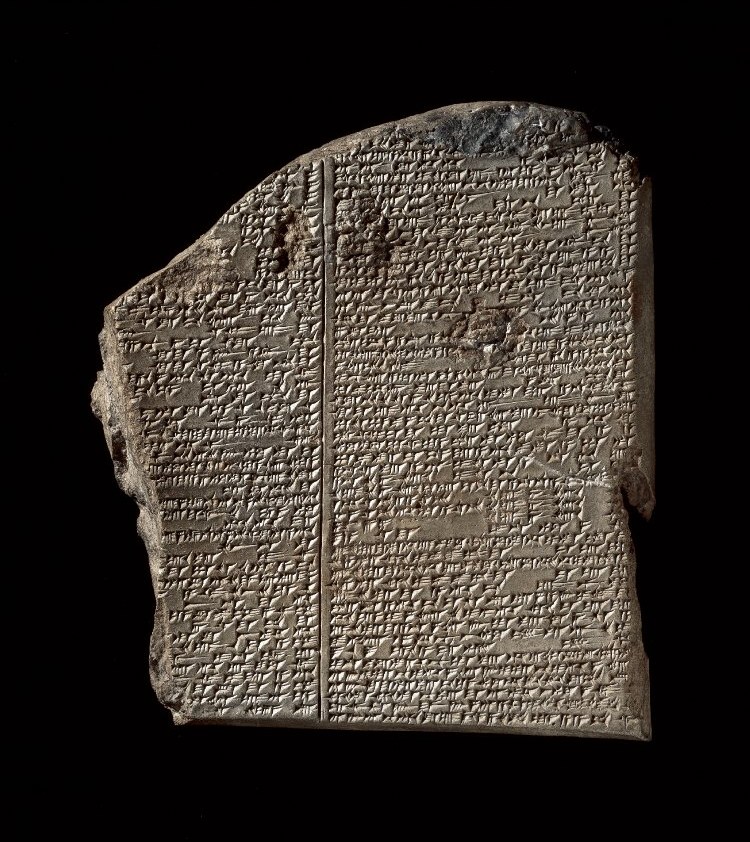
Ancient
*Atra-Hasis. Mesopotamia, 18th century BCE. In, e.g., W.G. Lambert and Alan Millard, A.R. Millard, ''Atra-Hasis: The Babylonian Story of the Flood''. Winona Lake, Indiana: Eisenbrauns, 1999. * *Ovid. ''Metamorphoses'', s:Metamorphoses (Miller)/Book I, book 1, lines 262–448. Rome, 8 CE. In, e.g., Ovid. ''Metamorphoses: The New, Annotated Edition''. Translated by Rolfe Humphries, annotated by Joseph D. Reed, pages 11–16, 404–05. Bloomington, Indiana: Indiana University Press, 2018. (flood).
*Ovid. ''Metamorphoses'', s:Metamorphoses (Miller)/Book I, book 1, lines 262–448. Rome, 8 CE. In, e.g., Ovid. ''Metamorphoses: The New, Annotated Edition''. Translated by Rolfe Humphries, annotated by Joseph D. Reed, pages 11–16, 404–05. Bloomington, Indiana: Indiana University Press, 2018. (flood).
Biblical
* (to be fruitful); (God's destruction ofEarly nonrabbinic
The Book of Noah
Jerusalem, early 2nd century BCE.
''The Genesis Apocryphon''
Dead Sea scrolls, Dead Sea scroll 1Q20. Land of Israel, 1st century BCE. In Géza Vermes. ''The Complete Dead Sea Scrolls in English'', pages 448, 450–53. New York: Penguin Press, 1997. *Josephus, ''Antiquities of the Jews'
book 1, chapter 3, paragraphs 2–3, 5, 7–8
Circa 93–94. In, e.g., ''The Works of Josephus: Complete and Unabridged, New Updated Edition''. Translated by William Whiston, pages 32–38. Peabody, Massachusetts: Hendrickson Publishers, 1987. *Qur'an s:Quran/3#31-41, 3:33–34; s:Quran/4#163-171, 4:163; s:Quran/6#83-90, 6:84; s:Quran/7#59-64, 7:59–64; s:Quran/9#67-72, 9:70; s:Quran/71, 71:1–28. Arabia, 7th century.
Classical rabbinic
*Chagigah 2:1
s:Translation:Mishnah/Seder Nezikin/Tractate Avot/Chapter 5/6, 6. Land of Israel, circa 200 CE. In, e.g., ''The Mishnah: A New Translation''. Translated by Jacob Neusner, pages 330, 411–12, 537, 604–05, 680, 686. New Haven: Yale University Press, 1988. *
2:3
Land of Israel, 5th century. In, e.g., ''Midrash Rabbah: Genesis''. Translated by Harry Freedman (rabbi), Harry Freedman and Maurice Simon, volume 1, pages 16, 32, 35, 44, 112, 131–33, 181, 191, 194, 197, 200, 207, 209–12, 229, 233–312, 315, 346, 421–22, 439, 464; volume 2, pages 511, 522, 531, 546, 561, 612, 669, 689. London: Soncino Press, 1939. *Leviticus Rabbah 17:5. Land of Israel, 5th century. In, e.g., ''Midrash Rabbah: Leviticus''. Translated by Harry Freedman and Maurice Simon. London: Soncino Press, 1939.
 *Babylonian
*Babylonian Berakhot 25b
Sasanian Empire, 6th century. In, e.g., ''Talmud Bavli''. Edited by Yisroel Simcha Schorr, Chaim Malinowitz, and Mordechai Marcus, 72 volumes. Brooklyn: Mesorah Pubs., 2006.
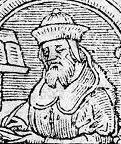
Medieval
*Rashi. ''Commentary''Genesis 6–11
Troyes, France, late 11th century. In, e.g., Rashi. ''The Torah: With Rashi's Commentary Translated, Annotated, and Elucidated''. Translated and annotated by Yisrael Isser Zvi Herczeg, volume 1, pages 65–114. Brooklyn: Mesorah Publications, 1995. *Abraham ibn Ezra. ''Commentary on the Torah''. Mid-12th century. In, e.g., ''Ibn Ezra's Commentary on the Pentateuch: Genesis (Bereshit)''. Translated and annotated by H. Norman Strickman and Arthur M. Silver, pages 98–148. New York: Menorah Publishing Company, 1988.
 *Maimonides. ''Mishneh Torah''
*Maimonides. ''Mishneh Torah''''Hilchot Avodat Kochavim V'Chukkoteihem (The Laws of the Worship of Stars and their Statutes)'', chapter 1, halachah 2
Egypt, circa 1170–1180. In, e.g., ''Mishneh Torah: Hilchot Avodat Kochavim V'Chukkoteihem: The Laws of the Worship of Stars and their Statutes''. Translated by Eliyahu Touger, volume 3, pages 16–21. New York: Moznaim Publishing, 1990. . *Maimonides. ''The Guide for the Perplexed'', part 1, chapters s:The Guide for the Perplexed (Friedlander)/Part I#CHAPTER VI, 6, s:The Guide for the Perplexed (Friedlander)/Part I#CHAPTER X, 10, s:The Guide for the Perplexed (Friedlander)/Part I#CHAPTER XLVII, 47–48; part 2, chapter s:Page:Guideforperplexed.djvu/303, 41; part 3, chapter s:Page:Guideforperplexed.djvu/368, 22. Cairo, Egypt, 1190. In, e.g., Moses Maimonides. ''The Guide for the Perplexed''. Translated by Michael Friedländer, pages 19, 23, 63–65, 235–36, 298–99. New York: Dover Publications, 1956. *Hezekiah ben Manoah. ''Hizkuni''. France, circa 1240. In, e.g., Chizkiyahu ben Manoach. ''Chizkuni: Torah Commentary''. Translated and annotated by Eliyahu Munk, volume 1, pages 66–102. Jerusalem: Ktav Publishers, 2013. *Nahmanides, Nachmanides. ''Commentary on the Torah''. Jerusalem, circa 1270. In, e.g., ''Ramban (Nachmanides): Commentary on the Torah: Genesis.'' Translated by Charles B. Chavel, volume 1, pages 105–63. New York: Shilo Publishing House, 1971. *''Midrash ha-Ne'lam (The Midrash of the Concealed)''. Spain, 13th century. In ''Zohar Chadash'', pages 20d–24a. Thessaloniki, Salonika, 1597. In, e.g., ''The Zohar: Pritzker Edition''. Translation and commentary by Nathan Wolski, volume 10, pages 223–74. Stanford, California: Stanford University Press, 2016. *''Zohar'', part 1, pages 59b–76b. Spain, late 13th century. In, e.g., ''The Zohar''. Translated by Harry Sperling and Maurice Simon, volume 1, pages 192–259. London: Soncino Press, 1934. And in, e.g., ''The Zohar: Pritzker Edition''. Translation and commentary by Daniel C. Matt, volume 1, pages 339–450. Stanford, California: Stanford University Press, 2004. *Bahya ben Asher. ''Commentary on the Torah''. Spain, early 14th century. In, e.g., ''Midrash Rabbeinu Bachya: Torah Commentary by Rabbi Bachya ben Asher''. Translated and annotated by Eliyahu Munk, volume 1, pages 163–215. Jerusalem: Lambda Publishers, 2003. *Isaac ben Moses Arama. ''Akedat Yizhak (The Binding of Isaac)''. Late 15th century. In, e.g., Yitzchak Arama. ''Akeydat Yitzchak: Commentary of Rabbi Yitzchak Arama on the Torah''. Translated and condensed by Eliyahu Munk, volume 1, pages 63–92. New York, Lambda Publishers, 2001.
Modern
*Isaac Abravanel. ''Commentary on the Torah''. Italy, between 1492 and 1509. In, e.g., ''Abarbanel: Selected Commentaries on the Torah: Volume 1: Bereishis/Genesis''. Translated and annotated by Israel Lazar, pages 54–81. Brooklyn: CreateSpace, 2015. *Obadiah ben Jacob Sforno. ''Commentary on the Torah''. Venice, 1567. In, e.g., ''Sforno: Commentary on the Torah''. Translation and explanatory notes by Raphael Pelcovitz, pages 40–61. Brooklyn: Mesorah Publications, 1997. *Moshe Alshich. ''Commentary on the Torah''. Safed, circa 1593. In, e.g., Moshe Alshich. ''Midrash of Rabbi Moshe Alshich on the Torah''. Translated and annotated by Eliyahu Munk, volume 1, pages 62–91. New York, Lambda Publishers, 2000.
*Menasseh Ben Israel, Menasseh ben Israel. ''El Conciliador (The Conciliator)''. Amsterdam, 1632. In ''The Conciliator of R. Manasseh Ben Israel: A Reconcilement of the Apparent Contradictions in Holy Scripture: To Which Are Added Explanatory Notes, and Biographical Notices of the Quoted Authorities''. Translated by Elias Hiam Lindo, pages 31–35, 37–49. London, 1842. Reprinted by, e.g., Nabu Press, 2010.
*Moshe Alshich. ''Commentary on the Torah''. Safed, circa 1593. In, e.g., Moshe Alshich. ''Midrash of Rabbi Moshe Alshich on the Torah''. Translated and annotated by Eliyahu Munk, volume 1, pages 62–91. New York, Lambda Publishers, 2000.
*Menasseh Ben Israel, Menasseh ben Israel. ''El Conciliador (The Conciliator)''. Amsterdam, 1632. In ''The Conciliator of R. Manasseh Ben Israel: A Reconcilement of the Apparent Contradictions in Holy Scripture: To Which Are Added Explanatory Notes, and Biographical Notices of the Quoted Authorities''. Translated by Elias Hiam Lindo, pages 31–35, 37–49. London, 1842. Reprinted by, e.g., Nabu Press, 2010.
 *Avraham Yehoshua Heschel. ''Commentaries on the Torah''. Kraków, Cracow, Poland, mid 17th century. Compiled as ''Chanukat HaTorah''. Edited by Chanoch Henoch Erzohn. Piotrków Trybunalski, Piotrkow, Poland, 1900. In Avraham Yehoshua Heschel. ''Chanukas HaTorah: Mystical Insights of Rav Avraham Yehoshua Heschel on Chumash''. Translated by Avraham Peretz Friedman, pages 41–47. Southfield, Michigan: Targum Press/Feldheim Publishers, 2004.
*Thomas Hobbes. ''Leviathan (Hobbes book), Leviathan'', part 3, chapters s:Leviathan/The Third Part#Chapter XXXIV: Of the Signification of Spirit, Angel, and Inspiration in the Books of Holy Scripture, 34, s:Leviathan/The Third Part#Chapter XXXVIII: Of the Signification in Scripture of Eternal Life, Hell, Salvation, the World to Come, and Redemption, 38. England, 1651. Reprint edited by C. B. Macpherson, pages 430–31, 486. Harmondsworth, England: Penguin Classics, 1982.
*Baruch Spinoza. ''Tractatus Theologico-Politicus, Theologico-Political Treatise'', chapters s:Theologico-Political Treatise 1862/Chapter 6, 6, s:Theologico-Political Treatise 1862/Chapter 8, 8. Amsterdam, 1670. In, e.g., Baruch Spinoza. ''Theological-Political Treatise''. Translated by Samuel Shirley, pages 78–79, 106–07. Indianapolis: Hackett Publishing Company, second edition, 2001.
*Avraham Yehoshua Heschel. ''Commentaries on the Torah''. Kraków, Cracow, Poland, mid 17th century. Compiled as ''Chanukat HaTorah''. Edited by Chanoch Henoch Erzohn. Piotrków Trybunalski, Piotrkow, Poland, 1900. In Avraham Yehoshua Heschel. ''Chanukas HaTorah: Mystical Insights of Rav Avraham Yehoshua Heschel on Chumash''. Translated by Avraham Peretz Friedman, pages 41–47. Southfield, Michigan: Targum Press/Feldheim Publishers, 2004.
*Thomas Hobbes. ''Leviathan (Hobbes book), Leviathan'', part 3, chapters s:Leviathan/The Third Part#Chapter XXXIV: Of the Signification of Spirit, Angel, and Inspiration in the Books of Holy Scripture, 34, s:Leviathan/The Third Part#Chapter XXXVIII: Of the Signification in Scripture of Eternal Life, Hell, Salvation, the World to Come, and Redemption, 38. England, 1651. Reprint edited by C. B. Macpherson, pages 430–31, 486. Harmondsworth, England: Penguin Classics, 1982.
*Baruch Spinoza. ''Tractatus Theologico-Politicus, Theologico-Political Treatise'', chapters s:Theologico-Political Treatise 1862/Chapter 6, 6, s:Theologico-Political Treatise 1862/Chapter 8, 8. Amsterdam, 1670. In, e.g., Baruch Spinoza. ''Theological-Political Treatise''. Translated by Samuel Shirley, pages 78–79, 106–07. Indianapolis: Hackett Publishing Company, second edition, 2001.
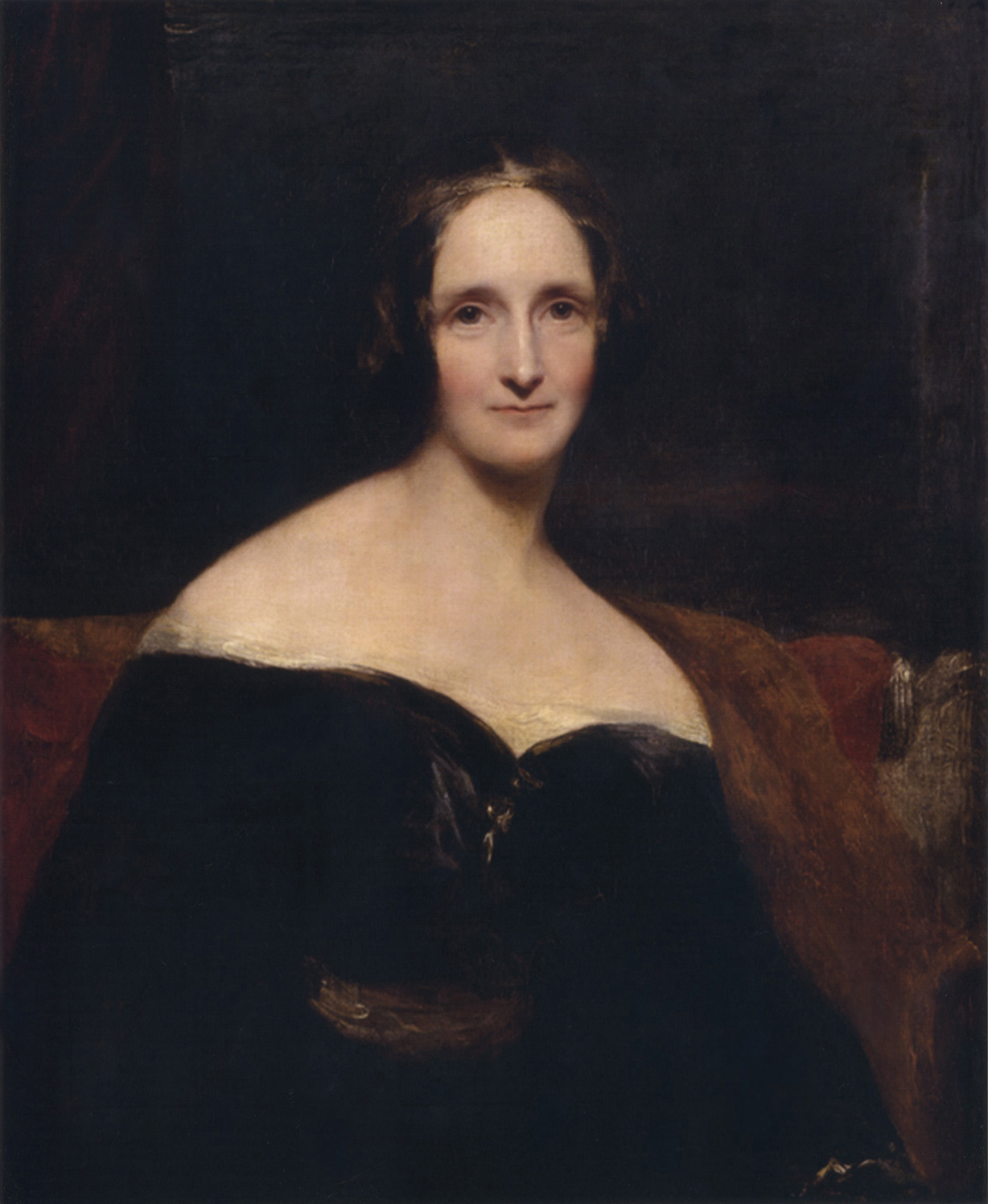 *Chaim ibn Attar. ''Ohr ha-Chaim''. Venice, 1742. In Chayim ben Attar. ''Or Hachayim: Commentary on the Torah''. Translated by Eliyahu Munk, volume 1, pages 92–117. Brooklyn: Lambda Publishers, 1999.
*Moses Mendelssohn.''Jerusalem (Mendelssohn), Jerusalem'', § 1. Berlin, 1783. In ''Jerusalem: Or on Religious Power and Judaism''. Translated by Allan Arkush; introduction and commentary by Alexander Altmann, page 70. Hanover, New Hampshire: Brandeis University Press, 1983.
*Chaim ibn Attar. ''Ohr ha-Chaim''. Venice, 1742. In Chayim ben Attar. ''Or Hachayim: Commentary on the Torah''. Translated by Eliyahu Munk, volume 1, pages 92–117. Brooklyn: Lambda Publishers, 1999.
*Moses Mendelssohn.''Jerusalem (Mendelssohn), Jerusalem'', § 1. Berlin, 1783. In ''Jerusalem: Or on Religious Power and Judaism''. Translated by Allan Arkush; introduction and commentary by Alexander Altmann, page 70. Hanover, New Hampshire: Brandeis University Press, 1983.
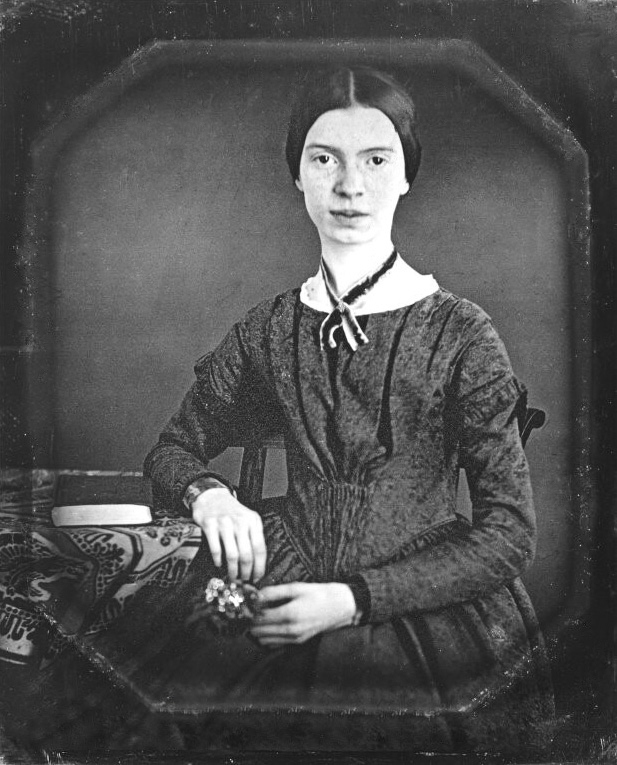 *Mary Shelley. ''Frankenstein, Frankenstein; or, The Modern Prometheus'', s:Frankenstein/Chapter 15, chapter 15. London: Lackington, Hughes, Harding, Mavor, & Jones, 1818. (alluding to ; ; and , the creature tells Victor Frankenstein, “God, in pity, made man beautiful and alluring, after his own image; but my form is a filthy type of yours, more horrid even from the very resemblance.”).
*"Mary Don't You Weep." United States, 19th century.
*Mary Shelley. ''Frankenstein, Frankenstein; or, The Modern Prometheus'', s:Frankenstein/Chapter 15, chapter 15. London: Lackington, Hughes, Harding, Mavor, & Jones, 1818. (alluding to ; ; and , the creature tells Victor Frankenstein, “God, in pity, made man beautiful and alluring, after his own image; but my form is a filthy type of yours, more horrid even from the very resemblance.”).
*"Mary Don't You Weep." United States, 19th century.
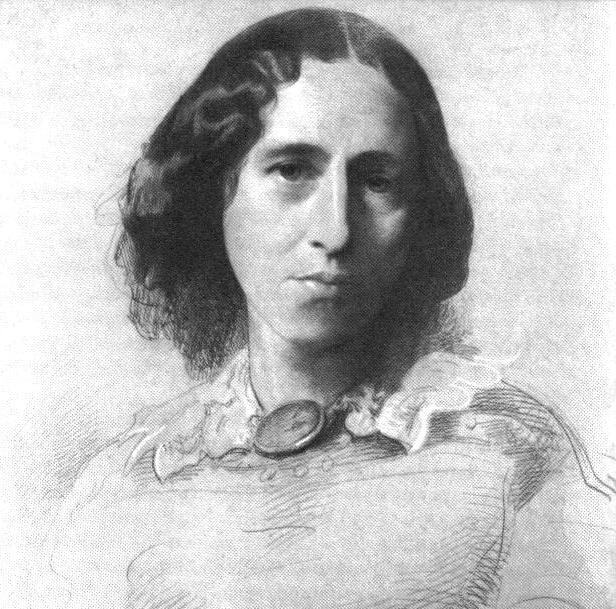 *Emily Dickinson. s:Once more, my now bewildered Dove, ''Poem 48 (Once more, my now bewildered Dove)''. Circa 1858. s:The Winters are so short —, ''Poem 403 (The Winters are so short —)''. Circa 1862. s:We talked with each other about each other, ''Poem 1473 (We talked with each other about each other)''. Circa 1879. In ''The Complete Poems of Emily Dickinson''. Edited by Thomas H. Johnson, pages 27, 192, 623. New York: Little, Brown & Co., 1960.
*George Eliot. ''Adam Bede'', s:Adam Bede/Chapter XXX, chapter 30. Edinburgh and London: William Blackwood and Sons, 1859. Reprinted, e.g., edited by Carol A. Martin, page 295. Oxford: Oxford University Press, 2008. (Dinah writes Seth, paraphrasing , “the rains that have fallen, as if the windows of heaven were opened again”).
*Emily Dickinson. s:Once more, my now bewildered Dove, ''Poem 48 (Once more, my now bewildered Dove)''. Circa 1858. s:The Winters are so short —, ''Poem 403 (The Winters are so short —)''. Circa 1862. s:We talked with each other about each other, ''Poem 1473 (We talked with each other about each other)''. Circa 1879. In ''The Complete Poems of Emily Dickinson''. Edited by Thomas H. Johnson, pages 27, 192, 623. New York: Little, Brown & Co., 1960.
*George Eliot. ''Adam Bede'', s:Adam Bede/Chapter XXX, chapter 30. Edinburgh and London: William Blackwood and Sons, 1859. Reprinted, e.g., edited by Carol A. Martin, page 295. Oxford: Oxford University Press, 2008. (Dinah writes Seth, paraphrasing , “the rains that have fallen, as if the windows of heaven were opened again”).
 *Samuel David Luzzatto (Shadal). ''Commentary on the Torah.'' Padua, 1871. In, e.g., Samuel David Luzzatto. ''Torah Commentary''. Translated and annotated by Eliyahu Munk, volume 1, pages 100–36. New York: Lambda Publishers, 2012.
*Malbim. ''The Torah and the Commandments''. Warsaw, 1874–80. In, e.g., Malbim: Rabbenu Meir Leibush ben Yechiel Michel. ''Malbim : Rabbenu Meir Leibush ben Yechiel Michel : commentary on the Torah''. Translated by Zvi Faier; Israel: M.P. Press/Hillel Press, 1982.
*Samuel David Luzzatto (Shadal). ''Commentary on the Torah.'' Padua, 1871. In, e.g., Samuel David Luzzatto. ''Torah Commentary''. Translated and annotated by Eliyahu Munk, volume 1, pages 100–36. New York: Lambda Publishers, 2012.
*Malbim. ''The Torah and the Commandments''. Warsaw, 1874–80. In, e.g., Malbim: Rabbenu Meir Leibush ben Yechiel Michel. ''Malbim : Rabbenu Meir Leibush ben Yechiel Michel : commentary on the Torah''. Translated by Zvi Faier; Israel: M.P. Press/Hillel Press, 1982.
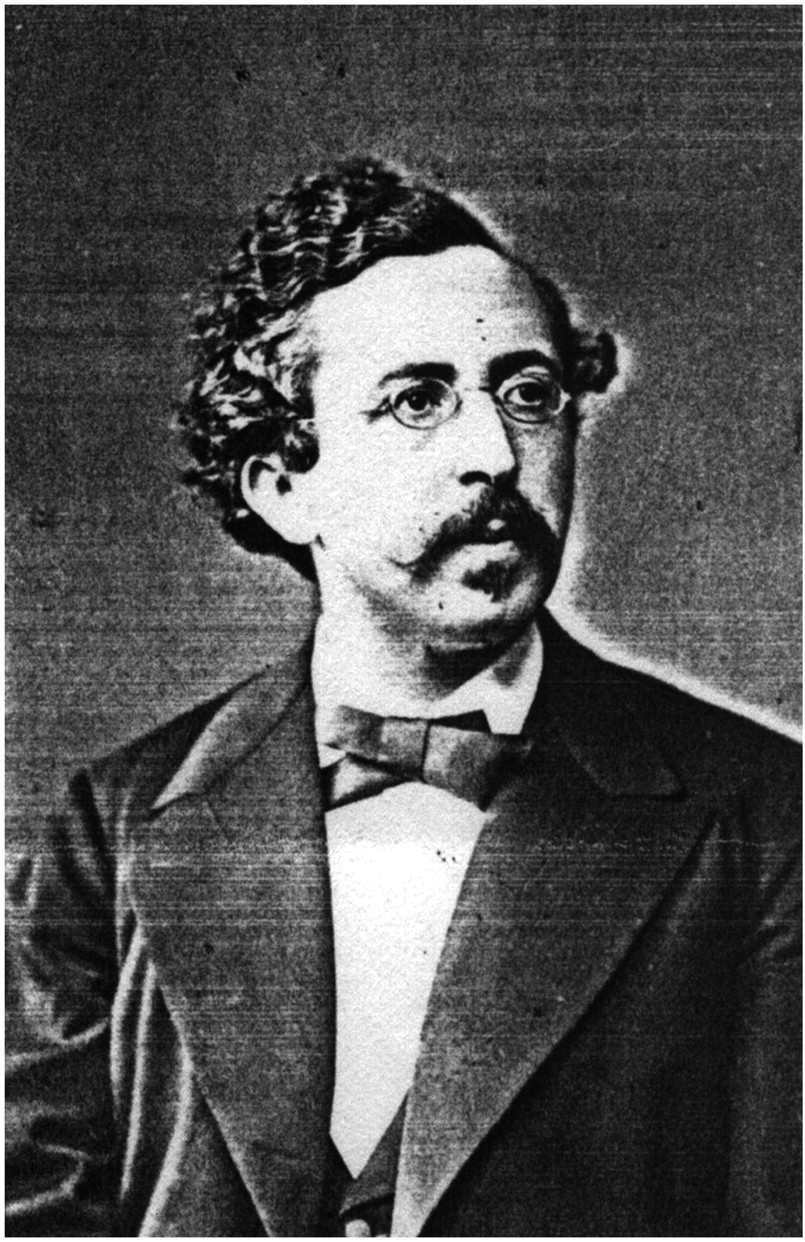 *Yehudah Aryeh Leib Alter. ''Sefat Emet''. Góra Kalwaria (Ger), Poland, before 1906. Excerpted in ''The Language of Truth: The Torah Commentary of Sefat Emet''. Translated and interpreted by Arthur Green, pages 13–17. Philadelphia: Jewish Publication Society, 1998. Reprinted 2012.
*Hermann Cohen. ''Religion of Reason: Out of the Sources of Judaism''. Translated with an introduction by Simon Kaplan; introductory essays by Leo Strauss, pages 117–18, 181. New York: Ungar, 1972. Reprinted Atlanta: Scholars Press, 1995. Originally published as ''Religion der Vernunft aus den Quellen des Judentums''. Leipzig: Gustav Fock, 1919.
*Benno Jacob. ''The First Book of the Bible: Genesis''. Translated by Ernest Jacob and Walter Jacob, pages 48–84. Jersey City, New Jersey: KTAV Publishing House, 1974. Originally published as ''Das erste Buch der Tora, Genesis: Übersetzt und erklärt von Benno Jacob''. Berlin: Schocken Verlag, 1934.
*Alexander Alan Steinbach. ''Sabbath Queen: Fifty-four Bible Talks to the Young Based on Each Portion of the Pentateuch'', pages 4–7. New York: Behrman's Jewish Book House, 1936.
*Yehudah Aryeh Leib Alter. ''Sefat Emet''. Góra Kalwaria (Ger), Poland, before 1906. Excerpted in ''The Language of Truth: The Torah Commentary of Sefat Emet''. Translated and interpreted by Arthur Green, pages 13–17. Philadelphia: Jewish Publication Society, 1998. Reprinted 2012.
*Hermann Cohen. ''Religion of Reason: Out of the Sources of Judaism''. Translated with an introduction by Simon Kaplan; introductory essays by Leo Strauss, pages 117–18, 181. New York: Ungar, 1972. Reprinted Atlanta: Scholars Press, 1995. Originally published as ''Religion der Vernunft aus den Quellen des Judentums''. Leipzig: Gustav Fock, 1919.
*Benno Jacob. ''The First Book of the Bible: Genesis''. Translated by Ernest Jacob and Walter Jacob, pages 48–84. Jersey City, New Jersey: KTAV Publishing House, 1974. Originally published as ''Das erste Buch der Tora, Genesis: Übersetzt und erklärt von Benno Jacob''. Berlin: Schocken Verlag, 1934.
*Alexander Alan Steinbach. ''Sabbath Queen: Fifty-four Bible Talks to the Young Based on Each Portion of the Pentateuch'', pages 4–7. New York: Behrman's Jewish Book House, 1936.
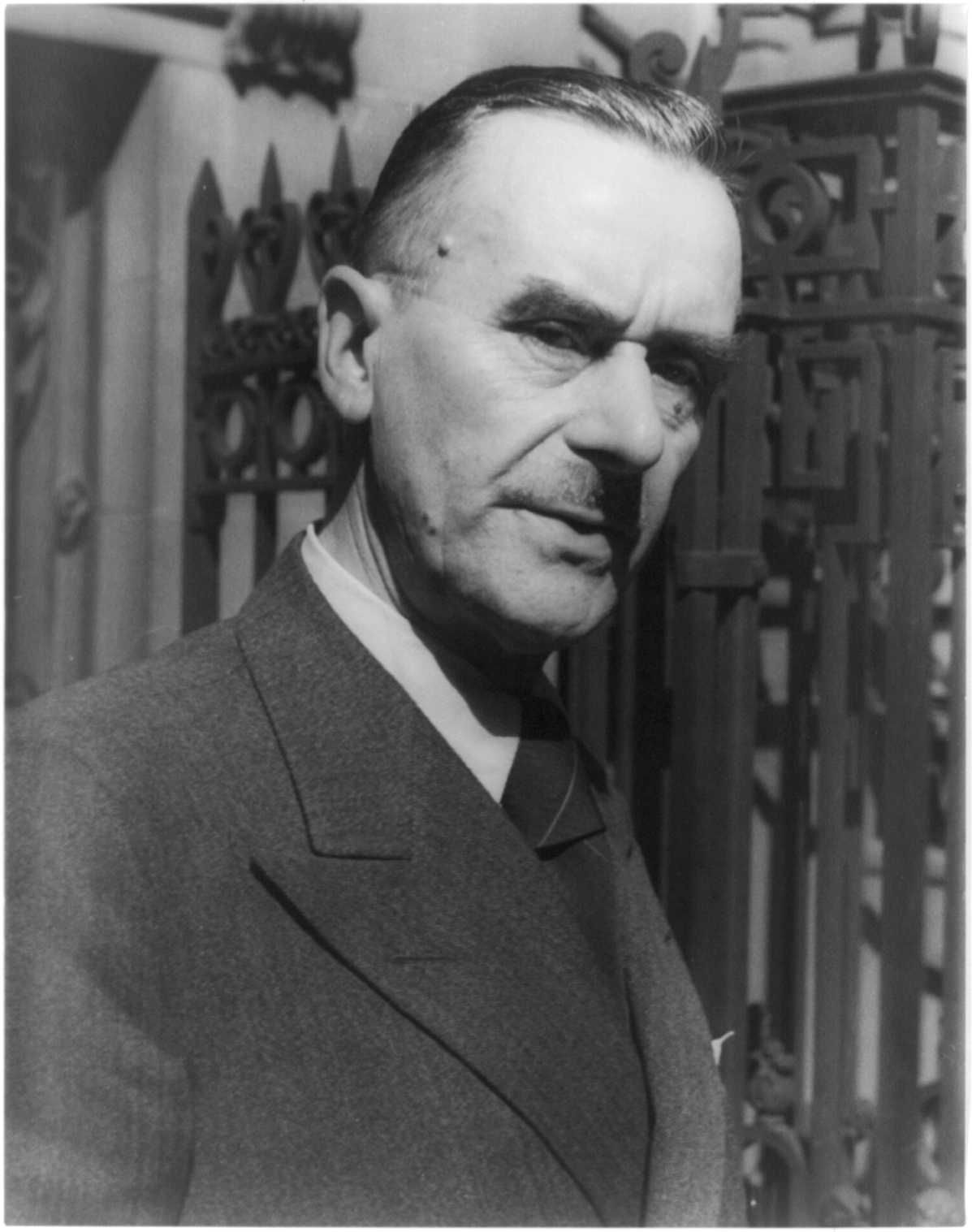 *Thomas Mann. ''Joseph and His Brothers''. Translated by John E. Woods (translator), John E. Woods, pages 5, 8–12, 15–16, 19–24, 35–36, 64, 68, 71, 73, 88–89, 107, 109, 154, 172, 183, 323–24, 333, 337, 339–41, 347, 355, 441–42, 447–48, 515, 547, 604–05, 715, 783, 806, 926. New York: Alfred A. Knopf, 2005. Originally published as ''Joseph und seine Brüder''. Stockholm: Bermann-Fischer Verlag, 1943.
*Umberto Cassuto. ''A Commentary on the Book of Genesis: Part Two: From Noah to Abraham''. Jerusalem, 1949. Translated by Israel Abrahams, pages 3–287. Jerusalem: The Magnes Press, Hebrew University of Jerusalem, The Hebrew University, 1964; reprinted 1974.
*Jay Macpherson. ''The Boatman''. Oxford University Press Canada, 1957.
*Jacob Hoftijzer. "Some Remarks to the Tale of Noah's Drunkenness." ''Oudtestamentische Studiën'', volume 12 (1958): pages 22–27.
*Thomas Mann. ''Joseph and His Brothers''. Translated by John E. Woods (translator), John E. Woods, pages 5, 8–12, 15–16, 19–24, 35–36, 64, 68, 71, 73, 88–89, 107, 109, 154, 172, 183, 323–24, 333, 337, 339–41, 347, 355, 441–42, 447–48, 515, 547, 604–05, 715, 783, 806, 926. New York: Alfred A. Knopf, 2005. Originally published as ''Joseph und seine Brüder''. Stockholm: Bermann-Fischer Verlag, 1943.
*Umberto Cassuto. ''A Commentary on the Book of Genesis: Part Two: From Noah to Abraham''. Jerusalem, 1949. Translated by Israel Abrahams, pages 3–287. Jerusalem: The Magnes Press, Hebrew University of Jerusalem, The Hebrew University, 1964; reprinted 1974.
*Jay Macpherson. ''The Boatman''. Oxford University Press Canada, 1957.
*Jacob Hoftijzer. "Some Remarks to the Tale of Noah's Drunkenness." ''Oudtestamentische Studiën'', volume 12 (1958): pages 22–27.
 *James Franklin Armstrong. "A Critical Note on Genesis Vi 16aα." ''Vetus Testamentum'', volume 10, number 1 (1960): pages 328–33.
*James Baldwin (writer), James Baldwin. ''The Fire Next Time''. 1963. Reprinted Modern Library, 1995.
*Walter Orenstein and Hertz Frankel. ''Torah and Tradition: A Bible Textbook for Jewish Youth: Volume I: Bereishis'', pages 13–24. New York: Hebrew Publishing Company, 1964.
*Ephraim Avigdor Speiser, Ephraim A. Speiser. ''Genesis: Introduction, Translation, and Notes'', pages 47–81. New York: Anchor Bible Series, Anchor Bible, 1964.
*Michael C. Astour. "Sabtah and Sabteca: Ethiopian Pharaoh Names in Genesis 10." ''Journal of Biblical Literature'', volume 84, number 4 (1965): pages 422–25.
*Walter S. Olson
*James Franklin Armstrong. "A Critical Note on Genesis Vi 16aα." ''Vetus Testamentum'', volume 10, number 1 (1960): pages 328–33.
*James Baldwin (writer), James Baldwin. ''The Fire Next Time''. 1963. Reprinted Modern Library, 1995.
*Walter Orenstein and Hertz Frankel. ''Torah and Tradition: A Bible Textbook for Jewish Youth: Volume I: Bereishis'', pages 13–24. New York: Hebrew Publishing Company, 1964.
*Ephraim Avigdor Speiser, Ephraim A. Speiser. ''Genesis: Introduction, Translation, and Notes'', pages 47–81. New York: Anchor Bible Series, Anchor Bible, 1964.
*Michael C. Astour. "Sabtah and Sabteca: Ethiopian Pharaoh Names in Genesis 10." ''Journal of Biblical Literature'', volume 84, number 4 (1965): pages 422–25.
*Walter S. Olson"Has Science Dated the Biblical Flood?"
''Zygon (journal), Zygon'', volume 2, number 3 (1967): pages 274–78. *James Barr (biblical scholar), James Barr
"The Image of God in the Book of Genesis — A Study of Terminology."
''Bulletin of the John Rylands Library'', volume 51, number 1 (1968): pages 11–26. *Samuel Noah Kramer
"The 'Babel of Tongues': A Sumerian Version."
''Journal of the American Oriental Society'', volume 88, number 1 (January–March 1968): pages 108–11. *Wilfred G. Lambert, W.G. Lambert and A.R. Millard. ''Atra–Ḫasīs: The Babylonian Story of the Flood''. Oxford: Oxford University Press, 1969. Reprinted Winona Lake, Indiana: Eisenbrauns, 1999. *Eugene J. Fisher
"Gilgamesh and Genesis: The Flood Story in Context."
''Catholic Biblical Quarterly'', volume 32, number 3 (1970): pages 392–403. *David J. A. Clines
"The Image of God in Man."
''Tyndale Bulletin'', volume 19 (1968): pages 53–103. *Frederick W. Bassett
"Noah's Nakedness and the Curse of Canaan: A Case of Incest?"
''Vetus Testamentum'', volume 21, number 2 (1971): pages 232–37. *W. Malcolm Clark. "The Flood and the Structure of the Pre–patriarchal History." ''Zeitschrift für die Alttestamentliche Wissenschaft'', volume 83, number 2 (1971): pages 184–211. *W. Malcolm Clark
"The Righteousness of Noah."
''Vetus Testamentum'', volume 21, number 3 (1971): pages 261–80. *David J. A. Clines
"Noah's Flood: I: The Theology of the Flood Narrative."
''Science and Christian Belief, Faith and Thought'', volume 100, number 2 (1972–73): pages 128–42. *Thomas C. Hartman
"Some Thoughts on the Sumerian King List and Genesis 5 and 11B."
''Journal of Biblical Literature'', volume 91, number 1 (March 1972): pages 25–32. *H. Hirsch Cohen. ''The Drunkenness of Noah''. Alabama: University of Alabama, 1974. *Tikva Frymer-Kensky
"What the Babylonian Flood Stories Can and Cannot Teach Us About the Genesis Flood."
''Biblical Archaeology Review'', volume 4, number 4 (1974): pages 32–41. *Isaac M. Kikawada. "The Shape of Genesis 11:1–9." In ''Rhetorical Criticism: Essays in Honor of James Muilenburg''. Edited by Jared J. Jackson and Martin Kessler, pages 18–32. Pittsburgh: Pickwick, 1974. *Albert L. Baumgarten. "Myth and Midrash: Genesis 9:20–29." In ''Christianity, Judaism and Other Greco-Roman Cults: Studies for Morton Smith at Sixty: Part Three: Judaism Before 70''. Edited by Jacob Neusner, pages 55–71. Leiden: Brill Academic Publishers, 1975. *Robert E. Longacre. "The Discourse Structure of the Flood Narrative." In ''Society of Biblical Literature Abstracts and Seminar Papers, 1976'', pages 235–62. *David L. Petersen
"The Yahwist on the Flood."
''Vetus Testamentum'', volume 26, number 4 (1976): pages 438–46. *Tikva Frymer-Kensky
"The Atrahasis Epic and Its Significance for Our Understanding of Genesis 1–9."
''Near Eastern Archaeology Magazine, Biblical Archaeologist'', volume 40, number 4 (1977): pages 147–55. *Gerhard Larsson. "Chronological Parallels Between the Creation and the Flood." ''Vetus Testamentum'', volume 27, number 4 (1977): pages 490–92. *Bernhard Anderson, Bernhard W. Anderson. "Babel: Unity and Diversity in God's Creation." ''Currents in Theology and Mission'', volume 5, number 2 (1978): pages 69–81. *Peter Craigie, Peter C. Craigie. ''The Problem of War in the Old Testament'', page 73. Grand Rapids, Michigan: William B. Eerdmans Publishing Company, 1978. *Gerhard Hasel, Gerhard F. Hasel
"The Genealogies of Gen 5 and 11 and Their Alleged Babylonian Background."
''Andrews University Seminary Studies'', volume 6 (1978): pages 361–74. *Robert B. Laurin. "The Tower of Babel Revisited." In ''Biblical and Near Eastern Studies: Essays in Honor of William Sanford La Sor''. Edited by Gary A. Tuttle, pages 142–45. Grand Rapids: Eerdmans, 1978. *Gordon Wenham, Gordon J. Wenham
"The Coherence of the Flood Narrative."
''Vetus Testamentum'', volume 28, number 3 (1978): pages 336–48. *Dale S. DeWitt
"The Historical Background of Genesis 11:1–9: Babel or Ur?"
''Journal of the Evangelical Theological Society'', volume 22, number 1 (1979): pages 15–26. *Mulford Q. Sibley
"Political Science, Moses, and Ancient Hebrew Thought."
''Political Research Quarterly, The Western Political Quarterly'', volume 32, number 2 (June 1979): pages 148–49. *Nahum M. Sarna. "The 'Tower of Babel' as a Clue to the Redactional Structuring of Primeval History [Gen. 1–11:9]." In ''The Bible World: Essays in Honor of Cyrus H. Gordon''. Edited by Gary Rendsburg, Ruth Adler, Milton Arfa, and Nathan H. Winter, pages 211–19. New York: Ktav, 1980. *Rosemary Courtney
"Noah's Flood."
''Institute of General Semantics, ETC: A Review of General Semantics'', volume 38, number 3 (Fall 1981): pages 269–71. *Nechama Leibowitz, Nehama Leibowitz. ''Studies in Bereshit (Genesis)'', pages 59–108. Jerusalem: The World Zionist Organization, 1981. Reprinted as ''New Studies in the Weekly Parasha''. Lambda Publishers, 2010. *Walter Brueggemann. ''Genesis: Interpretation: A Bible Commentary for Teaching and Preaching'', pages 73–104. Atlanta: John Knox Press, 1982. *Cyrus H. Gordon. "Ebia and Genesis 11." In ''A Spectrum of Thought: Essays in Honor of Dennis F. Kinlaw, Dennis Kinlaw''. Edited by Michael L. Peterson, pages 125–34. Wilmore, Kentucky: Francis Asbury Publishing, 1982.
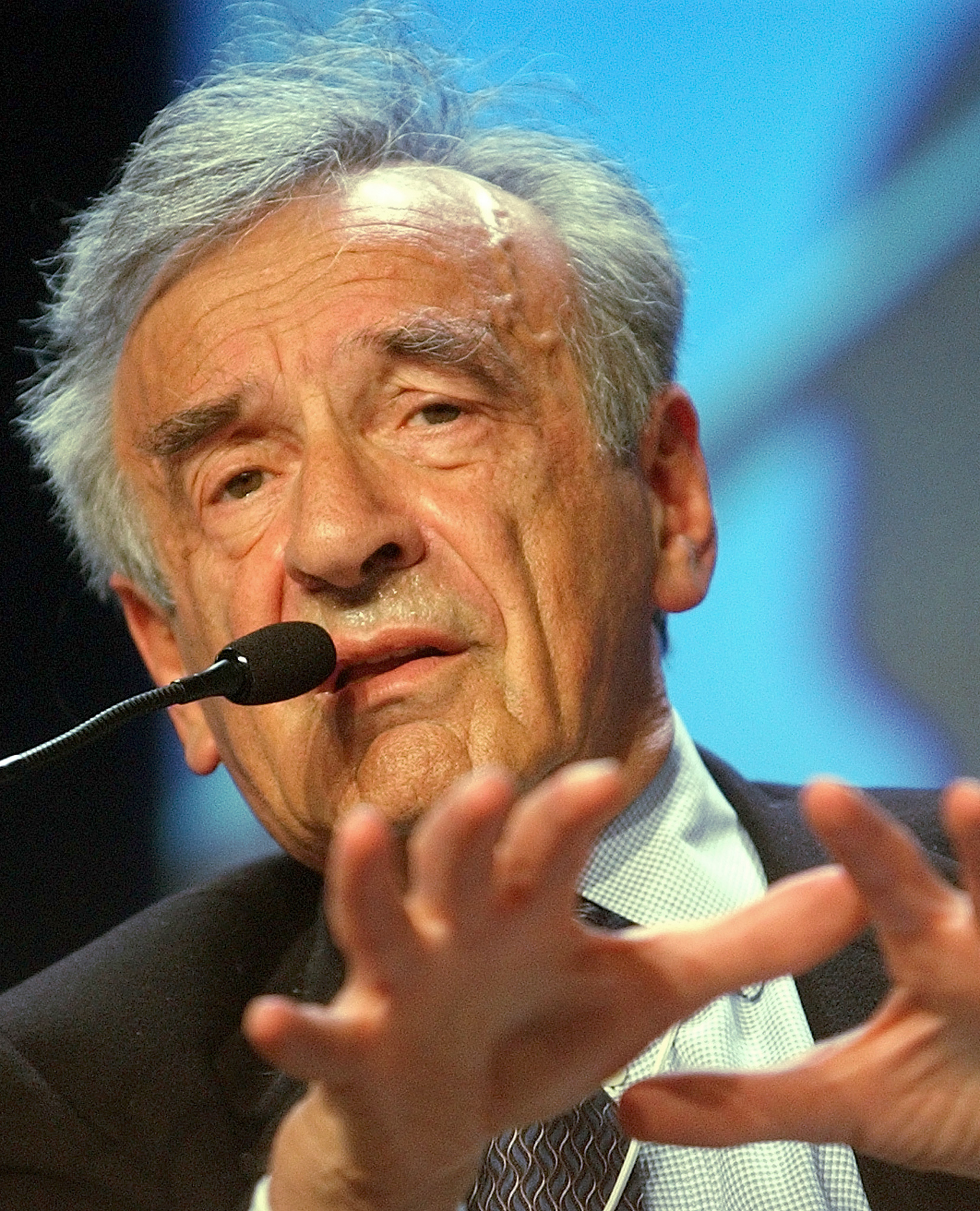 *Jack P. Lewis
*Jack P. Lewis"Noah and the Flood: In Jewish, Christian, and Muslim Tradition."
''Biblical Archaeologist'', volume 47, number 4 (December 1984): pages 224–39. *Elie Wiesel
"Noah's Warning."
''Religion & Literature'', volume 16, number 1 (winter 1984): pages 3–20. In ''Sages and Dreamers: Biblical, Talmudic, and Hasidic Portraits and Legends'', pages 19–34. New York: Summit Books, 1991. *Isaac M. Kikawada and Arthur Quinn, ''Before Abraham Was: The Unity of Genesis 1–11''. Nashville: Abingdon, 1985. *Pinchas Hacohen Peli, Pinchas H. Peli. ''Torah Today: A Renewed Encounter with Scripture'', pages 7–10. Washington, D.C.: B'nai B'rith Books, 1987.
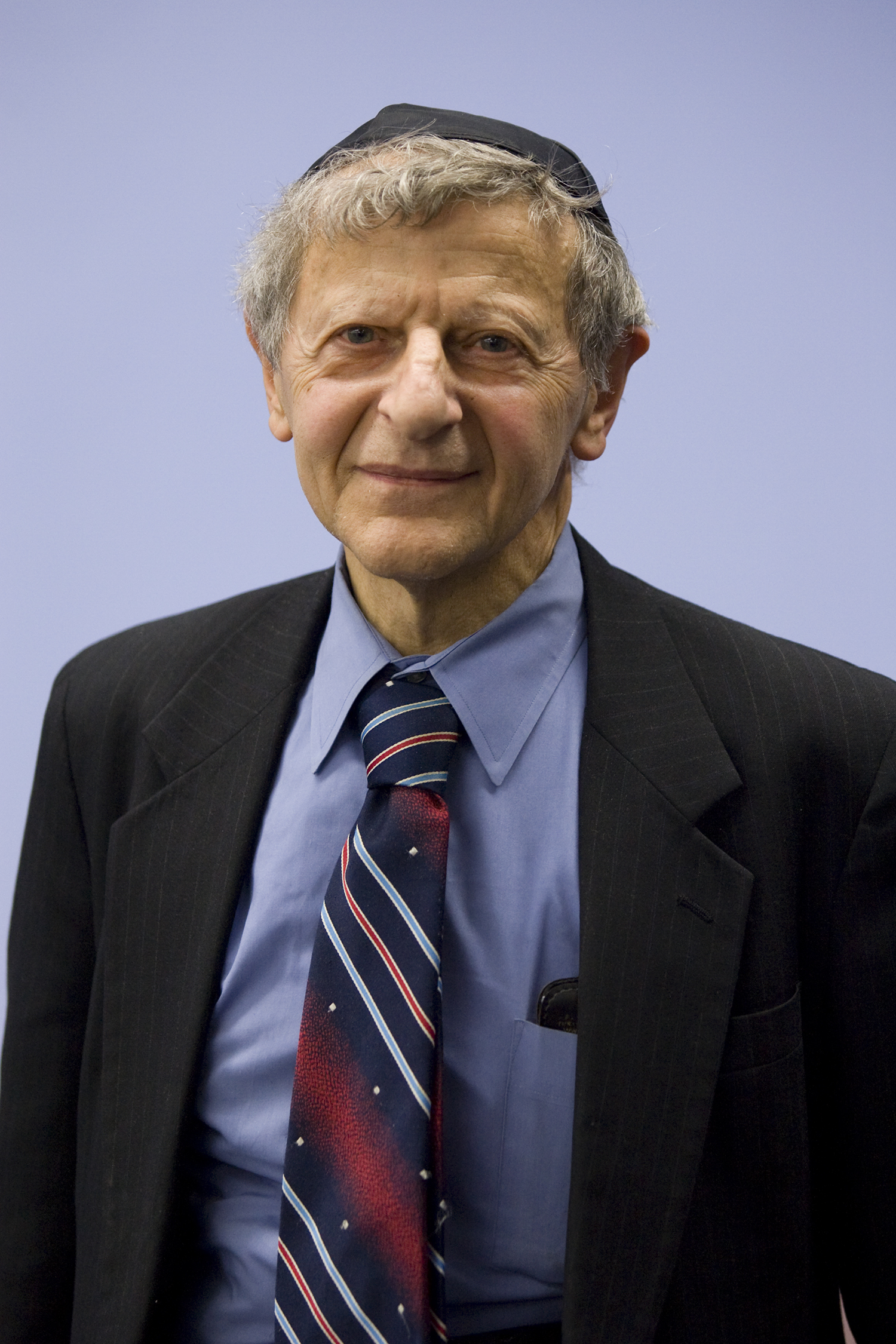 *Louis Feldman, Louis H. Feldman
*Louis Feldman, Louis H. Feldman"Josephus' Portrait of Noah and Its Parallels in Philo, Pseudo-Philo's 'Biblical Antiquities,' and Rabbinic Midrashim."
''Proceedings of the American Academy for Jewish Research'', volume 55 (1988): pages 31–57. *Lloyd R. Bailey. ''Noah: The Person and Story in History and Tradition''. University of South Carolina Press, 1989. *Marc Gellman. ''Does God Have a Big Toe? Stories About Stories in the Bible'', pages 27–45. New York: HarperCollins, 1989. *Rolf Rendtorff
"'Covenant' as a Structuring Concept in Genesis and Exodus."
''Journal of Biblical Literature'', volume 108, number 3 (Autumn 1989): pages 385–93. *Nahum M. Sarna. ''The JPS Torah Commentary: Genesis: The Traditional Hebrew Text with the New JPS Translation'', pages 47–88, 376–77. Philadelphia: Jewish Publication Society, 1989. *Mark S. Smith. ''The Early History of God: Yahweh and the Other Deities in Ancient Israel'', page 102. New York: HarperSanFrancisco, 1990. (). *Mario Brelich. ''Navigator of the Flood''. Marlboro, Vermont: Marlboro Press, 1991. *Robert A. Di Vito. "The Demarcation of Divine and Human Realms in Genesis 2–11." In ''Creation in the Biblical Traditions''. Edited by Richard J. Clifford and John J. Collins, pages 39–56. Washington, D.C.: Catholic Biblical Association of America, 1992. *Aaron Wildavsky. ''Assimilation versus Separation: Joseph the Administrator and the Politics of Religion in Biblical Israel'', page 5. New Brunswick, New Jersey: Transaction Publishers, 1993. *''I Studied Inscriptions from Before the Flood: Ancient Near Eastern, Literary, and Linguistic Approaches to Genesis 1–11''. Edited by Richard Hess, Richard S. Hess and David Toshio Tsumura. Winona Lake, Indiana: Eisenbrauns, 1994. *Judith S. Antonelli. "Naamah: Survivor of the Flood." In ''In the Image of God: A Feminist Commentary on the Torah'', pages 19–26. Northvale, New Jersey: Jason Aronson, 1995. *Jacob Milgrom. "Bible Versus Babel: Why did God tell Abraham to leave Mesopotamia, the most advanced civilization of its time, for the backwater region of Canaan?" ''Bible Review'', volume 11, number 2 (April 1995). *Frank H. Polak
"The Restful Waters of Noah."
''Journal of the Ancient Near Eastern Society'', volume 23 (1995): pages 69–74. *Naomi H. Rosenblatt and Joshua Horwitz. ''Wrestling With Angels: What Genesis Teaches Us About Our Spiritual Identity, Sexuality, and Personal Relationships'', pages 65–92. Delacorte Press, 1995. *Avivah Gottlieb Zornberg. ''The Beginning of Desire: Reflections on Genesis'', pages 37–71. New York: Image Books/Doubelday, 1995. *Karen Armstrong. ''In the Beginning: A New Interpretation of Genesis'', pages 39–53. New York: Knopf, 1996. *Norman Cohn. ''Noah's Flood: The Genesis Story in Western Thought''. New Haven: Yale Univ. Press, 1996. *Ellen Frankel. ''The Five Books of Miriam: A Woman's Commentary on the Torah'', pages 11–14. New York: G. P. Putnam's Sons, 1996.
 *Marc Gellman. ''God's Mailbox: More Stories About Stories in the Bible'', pages 24–29, 107–11. New York: Morrow Junior Books, 1996.
*James K. Morrow, James Morrow. "Bible Stories for Adults, No. 17: The Deluge" and "Bible Stories for Adults, No. 20: The Tower." In ''Bible Stories for Adults'', pages 1–14, 61–84. New York: Harcourt Brace & Company, 1996.
*Marc Gellman. ''God's Mailbox: More Stories About Stories in the Bible'', pages 24–29, 107–11. New York: Morrow Junior Books, 1996.
*James K. Morrow, James Morrow. "Bible Stories for Adults, No. 17: The Deluge" and "Bible Stories for Adults, No. 20: The Tower." In ''Bible Stories for Adults'', pages 1–14, 61–84. New York: Harcourt Brace & Company, 1996.
 *Gunther Plaut, W. Gunther Plaut. ''The Haftarah Commentary'', pages 13–22. New York: UAHC Press, 1996.
*Sorel Goldberg Loeb and Barbara Binder Kadden. ''Teaching Torah: A Treasury of Insights and Activities'', pages 11–18. Denver: A.R.E. Publishing, 1997.
*Gunther Plaut, W. Gunther Plaut. ''The Haftarah Commentary'', pages 13–22. New York: UAHC Press, 1996.
*Sorel Goldberg Loeb and Barbara Binder Kadden. ''Teaching Torah: A Treasury of Insights and Activities'', pages 11–18. Denver: A.R.E. Publishing, 1997.
 *Jacob Migrom. "The Blood Taboo: Blood should not be ingested because it contains life. Whoever does so is guilty of murder." ''Bible Review'', volume 13, number 4 (August 1997).
*Susan Freeman. ''Teaching Jewish Virtues: Sacred Sources and Arts Activities'', pages 4–6, 55–68, 269–82. Springfield Township, Union County, New Jersey, Springfield, New Jersey: A.R.E. Publishing, 1999. (; ).
*William Ryan and Walter Pitman. ''Noah's Flood: The New Scientific Discoveries About the Event that Changed History''. New York: Simon & Schuster, 1999.
*Adin Steinsaltz. ''Simple Words: Thinking About What Really Matters in Life'', page 49. New York: Simon & Schuster, 1999.
*Tamara Goshen-Gottstein. “The Souls that They Made: Physical Infertility and Spiritual Fecundity.” In ''Torah of the Mothers: Contemporary Jewish Women Read Classical Jewish Texts''. Edited by Ora Wiskind Elper and Susan Handelman, pages 123–54. New York and Jerusalem: Urim Publications, 2000. ().
*John S. Kselman. "Genesis." In ''The HarperCollins Bible Commentary''. Edited by James Luther Mays, James L. Mays, pages 88–91. New York: HarperCollins Publishers, revised edition, 2000.
*Julie Ringold Spitzer. "Mrs. Noah." In ''The Women's Torah Commentary: New Insights from Women Rabbis on the 54 Weekly Torah Portions''. Edited by Elyse Goldstein, pages 53–56. Woodstock, Vermont: Jewish Lights Publishing, 2000.
*Jacob Migrom. "The Blood Taboo: Blood should not be ingested because it contains life. Whoever does so is guilty of murder." ''Bible Review'', volume 13, number 4 (August 1997).
*Susan Freeman. ''Teaching Jewish Virtues: Sacred Sources and Arts Activities'', pages 4–6, 55–68, 269–82. Springfield Township, Union County, New Jersey, Springfield, New Jersey: A.R.E. Publishing, 1999. (; ).
*William Ryan and Walter Pitman. ''Noah's Flood: The New Scientific Discoveries About the Event that Changed History''. New York: Simon & Schuster, 1999.
*Adin Steinsaltz. ''Simple Words: Thinking About What Really Matters in Life'', page 49. New York: Simon & Schuster, 1999.
*Tamara Goshen-Gottstein. “The Souls that They Made: Physical Infertility and Spiritual Fecundity.” In ''Torah of the Mothers: Contemporary Jewish Women Read Classical Jewish Texts''. Edited by Ora Wiskind Elper and Susan Handelman, pages 123–54. New York and Jerusalem: Urim Publications, 2000. ().
*John S. Kselman. "Genesis." In ''The HarperCollins Bible Commentary''. Edited by James Luther Mays, James L. Mays, pages 88–91. New York: HarperCollins Publishers, revised edition, 2000.
*Julie Ringold Spitzer. "Mrs. Noah." In ''The Women's Torah Commentary: New Insights from Women Rabbis on the 54 Weekly Torah Portions''. Edited by Elyse Goldstein, pages 53–56. Woodstock, Vermont: Jewish Lights Publishing, 2000.
 *Robert Bly
*Robert Bly"Noah Watching the Rain."
In ''The Night Abraham Called to the Stars: Poems'', page 89. New York: HarperCollins/Perennial, 2001. *Lainie Blum Cogan and Judy Weiss. ''Teaching Haftarah: Background, Insights, and Strategies'', pages 314–23. Denver: A.R.E. Publishing, 2002. *Michael Fishbane. ''The JPS Bible Commentary: Haftarot'', pages 11–17. Philadelphia: Jewish Publication Society, 2002. *Tikva Frymer-Kensky. "To the Barricades: Views against the Other." In ''Reading the Women of the Bible'', pages 199–208. New York: Schocken Books, 2002. (the curse and genealogy of Canaan). *Ian Wilson (author), Ian Wilson. ''Before the Flood: The Biblical Flood as a Real Event and How It Changed the Course of Civilization''. New York: St. Martin's Griffin, 2002. *David M. Goldenberg. ''The Curse of Ham: Race and Slavery in Early Judaism, Christianity, and Islam''. Princeton University Press, 2003. *Rodger Kamenetz. "Noah's Grapes." In ''The Lowercase Jew,'' page 38. Evanston, Illinois: Triquarterly Books/Northwestern University Press, 2003.
 *Leon Kass, Leon R. Kass. ''The Beginning of Wisdom: Reading Genesis'', pages 151–243. New York: Free Press, 2003.
*Joseph Telushkin. ''The Ten Commandments of Character: Essential Advice for Living an Honorable, Ethical, Honest Life'', pages 87–91, 275–78. New York: Bell Tower, 2003.
*Robert Alter. ''The Five Books of Moses: A Translation with Commentary'', pages 40–61. New York: W.W. Norton & Co., 2004.
*Jon D. Levenson. "Genesis." In ''The Jewish Study Bible''. Edited by Adele Berlin and Marc Zvi Brettler, pages 21–30. New York: Oxford University Press, 2004.
*David Maine. ''The Preservationist''. New York: St. Martin's Press, 2004.
*Kacy Barnett-Gramckow. ''The Heavens Before''. Chicago: Moody, 2004.
*Kacy Barnett-Gramckow. ''He Who Lifts the Skies''. Chicago: Moody, 2004.
*Kacy Barnett-Gramckow. ''A Crown in the Stars''. Chicago: Moody, 2005.
*John S. Bergsma and Scott W. Hahn
*Leon Kass, Leon R. Kass. ''The Beginning of Wisdom: Reading Genesis'', pages 151–243. New York: Free Press, 2003.
*Joseph Telushkin. ''The Ten Commandments of Character: Essential Advice for Living an Honorable, Ethical, Honest Life'', pages 87–91, 275–78. New York: Bell Tower, 2003.
*Robert Alter. ''The Five Books of Moses: A Translation with Commentary'', pages 40–61. New York: W.W. Norton & Co., 2004.
*Jon D. Levenson. "Genesis." In ''The Jewish Study Bible''. Edited by Adele Berlin and Marc Zvi Brettler, pages 21–30. New York: Oxford University Press, 2004.
*David Maine. ''The Preservationist''. New York: St. Martin's Press, 2004.
*Kacy Barnett-Gramckow. ''The Heavens Before''. Chicago: Moody, 2004.
*Kacy Barnett-Gramckow. ''He Who Lifts the Skies''. Chicago: Moody, 2004.
*Kacy Barnett-Gramckow. ''A Crown in the Stars''. Chicago: Moody, 2005.
*John S. Bergsma and Scott W. Hahn"Noah's Nakedness and Curse on Canaan (Genesis 9:20–27)."
''Journal of Biblical Literature'', volume 124, number 1 (2005): pages 25–40. *''Professors on the Parashah: Studies on the Weekly Torah Reading'' Edited by Leib Moscovitz, pages 25–30. Jerusalem: Urim Publications, 2005. *Muhammad Abdel-Haleem, Muhammad A.S. Abdel Haleem
"The Qur'anic Employment of the Story of Noah."
''Journal of Qur'anic Studies'', volume 8, number 1 (2006): pages 38–57. *W. Gunther Plaut. ''The Torah: A Modern Commentary: Revised Edition''. Revised edition edited by David E. Stern, David E.S. Stern, pages 57–87. New York: Union for Reform Judaism, 2006.
 *Khalid Sindawi
*Khalid Sindawi"Noah and Noah's Ark as the Primordial Model of Shīʿism in Shīʿite Literature."
''Quaderni di Studi Arabi'' (new series), volume 1 (2006): pages 29–48. *Michael E. Stone
"The Book(s) Attributed to Noah."
''Dead Sea Discoveries'', volume 13, number 1 (2006): pages 4–23. *Suzanne A. Brody. "Coloring." In ''Dancing in the White Spaces: The Yearly Torah Cycle and More Poems'', page 63. Shelbyville, Kentucky: Wasteland Press, 2007.
 *Esther Jungreis. ''Life Is a Test'', pages 168, 218–19, 229–30. Brooklyn: Shaar Press, 2007.
*James Kugel, James L. Kugel. ''How To Read the Bible: A Guide to Scripture, Then and Now'', pages 69–88, 90, 92, 97, 108, 649, 658. New York: Free Press, 2007.
*Steven D. Mason
*Esther Jungreis. ''Life Is a Test'', pages 168, 218–19, 229–30. Brooklyn: Shaar Press, 2007.
*James Kugel, James L. Kugel. ''How To Read the Bible: A Guide to Scripture, Then and Now'', pages 69–88, 90, 92, 97, 108, 649, 658. New York: Free Press, 2007.
*Steven D. Mason“Another Flood? Genesis 9 and Isaiah's Broken Eternal Covenant.”
''Journal for the Study of the Old Testament'', volume 32, number 2 (December 2007): pages 177–98 *Andrei Orlov
"The Heir of Righteousness and the King of Righteousness: The Priestly Noachic Polemics in 2 Enoch and the Epistle to the Hebrews."
''The Journal of Theological Studies'' (new series), volume 58, number 1 (April 2007): pages 45–65. *Basya Schechter. “Yona.” In Pharaoh's Daughter. ''Haran''. 2007. *Steven Greenberg (rabbi), Steven Greenberg. "From Delight to Destruction: The Double-Faced Power of Sex: Parashat Noach (Genesis 6:9–11:32)." In ''Torah Queeries: Weekly Commentaries on the Hebrew Bible''. Edited by Gregg Drinkwater, Joshua Lesser, and David Shneer; foreword by Judith Plaskow, pages 19–23. New York: New York University Press, 2009. *Laura Lieber
"Portraits of Righteousness: Noah in Early Christian and Jewish Hymnography."
''Zeitschrift für Religions und Geistesgeschichte'', volume 61, number 4 (2009) : pages 332–55. *''The Torah: A Women's Commentary''. Edited by Tamara Cohn Eskenazi and Andrea Weiss (rabbi), Andrea L. Weiss, pages 35–58. New York: Union for Reform Judaism, URJ Press, 2008. *Jonathan Goldstein (author), Jonathan Goldstein. "Noah and the Ark" and "The Tower of Babel." In ''Ladies and Gentlemen, the Bible!'', pages 44–78. New York: Riverhead Books, 2009. *Reuven Hammer. ''Entering Torah: Prefaces to the Weekly Torah Portion'', pages 11–15. New York: Gefen Publishing House, 2009.
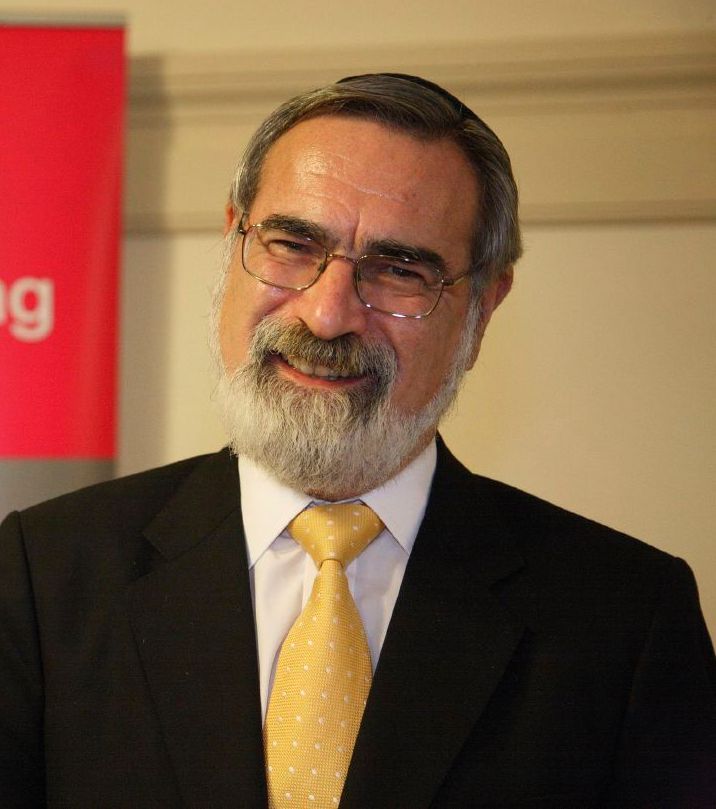 *Jonathan Sacks. ''Covenant & Conversation: A Weekly Reading of the Jewish Bible: Genesis: The Book of Beginnings'', pages 41–64. New Milford, Connecticut: Maggid Books, 2009.
*T.K. Thorne. ''Noah's Wife.'' Fountain Hills, Arizona: Chalet Publishers, 2009.
*John H. Walton. "Genesis." In ''Zondervan Illustrated Bible Backgrounds Commentary''. Edited by John H. Walton, volume 1, pages 46–68. Grand Rapids, Michigan: Zondervan, 2009.
*Mark A. Awabdy
*Jonathan Sacks. ''Covenant & Conversation: A Weekly Reading of the Jewish Bible: Genesis: The Book of Beginnings'', pages 41–64. New Milford, Connecticut: Maggid Books, 2009.
*T.K. Thorne. ''Noah's Wife.'' Fountain Hills, Arizona: Chalet Publishers, 2009.
*John H. Walton. "Genesis." In ''Zondervan Illustrated Bible Backgrounds Commentary''. Edited by John H. Walton, volume 1, pages 46–68. Grand Rapids, Michigan: Zondervan, 2009.
*Mark A. Awabdy“Babel, Suspense, and the Introduction to the Terah-Abram Narrative.”
''Journal for the Study of the Old Testament'', volume 35, number 1 (September 2010): pages 3–29. *Mary Katherine Y.H. Hom
“‘…A Mighty Hunter before YHWH’: Genesis 10:9 and the Moral-Theological Evaluation of Nimrod.”
''Vetus Testamentum'', volume 60, number 1 (2010): pages 63–68.
"Natural Law in Noahic Accent: A Covenantal Conception of Natural Law Drawn from Genesis 9."
''Journal of the Society of Christian Ethics'', volume 30, number 2 (Fall/Winter 2010): pages 131–49. *Brad Embry
“The ‘Naked Narrative’ from Noah to Leviticus: Reassessing Voyeurism in the Account of Noah’s Nakedness in Genesis 9.22–24.”
''Journal for the Study of the Old Testament'', volume 35, number 4 (June 2011): pages 417–33. *Jeannie St. John Taylor. ''City of a Thousand Gods: The Story of Noah's Daughter-in-Law''. Living Clay, 2011. *Calum Carmichael. ''The Book of Numbers: A Critique of Genesis'', pages 11, 19, 69, 108, 114, 118. New Haven: Yale University Press, 2012.
 *Joydeb Chitrakar and Gita Wolf. ''The Enduring Ark''. Chennai, India: Tara Books, 2012. (Indian version of the story of Noah's Ark, illustrated by Bengali Patua scroll painter).
*William G. Dever. ''The Lives of Ordinary People in Ancient Israel: When Archaeology and the Bible Intersect'', page 46. Grand Rapids, Michigan: William B. Eerdmans Publishing Company, 2012.
*Shmuel Herzfeld. "Failure: It's No Big Deal." In ''Fifty-Four Pick Up: Fifteen-Minute Inspirational Torah Lessons'', pages 7–11. Jerusalem: Gefen Publishing House, 2012.
*Irving Finkel. ''The Ark Before Noah: Decoding the Story of the Flood''. London: Hodder & Stoughton, 2014.
*Ralph Amelan. "Guarantor of the natural world." ''The Jerusalem Report'', volume 25, number 15 (November 3, 2014): page 47.
*Ralph Amelan. "Defining the Jews: Irving Finkel proposes a theory that accounts for the birth of the Hebrew Bible and how the story of Noah and the Flood came to be in it." ''The Jerusalem Report'', volume 25, number 18 (December 15, 2014): pages 42–45.
*Richard Faussette
*Joydeb Chitrakar and Gita Wolf. ''The Enduring Ark''. Chennai, India: Tara Books, 2012. (Indian version of the story of Noah's Ark, illustrated by Bengali Patua scroll painter).
*William G. Dever. ''The Lives of Ordinary People in Ancient Israel: When Archaeology and the Bible Intersect'', page 46. Grand Rapids, Michigan: William B. Eerdmans Publishing Company, 2012.
*Shmuel Herzfeld. "Failure: It's No Big Deal." In ''Fifty-Four Pick Up: Fifteen-Minute Inspirational Torah Lessons'', pages 7–11. Jerusalem: Gefen Publishing House, 2012.
*Irving Finkel. ''The Ark Before Noah: Decoding the Story of the Flood''. London: Hodder & Stoughton, 2014.
*Ralph Amelan. "Guarantor of the natural world." ''The Jerusalem Report'', volume 25, number 15 (November 3, 2014): page 47.
*Ralph Amelan. "Defining the Jews: Irving Finkel proposes a theory that accounts for the birth of the Hebrew Bible and how the story of Noah and the Flood came to be in it." ''The Jerusalem Report'', volume 25, number 18 (December 15, 2014): pages 42–45.
*Richard Faussette"The Biblical Significance of the Tower of Babel."
(2015). *Carol M. Kaminski. ''Was Noah Good?: Finding Favour in the Flood Narrative''. New York: Bloomsbury T&T Clark, 2015.*Jonathan Sacks. ''Lessons in Leadership: A Weekly Reading of the Jewish Bible'', pages 7–12. New Milford, Connecticut: Maggid Books, 2015. *Joseph Blenkinsopp
“The First Family: Terah and Sons.”
''Journal for the Study of the Old Testament'', volume 41, number 1 (September 2016): pages 3–13. *Hubert Damisch
"Noah's Ark."
''Architectural Association School of Architecture, AA Files'', number 72 (2016): pages 115–26. *Jean-Pierre Isbouts. ''Archaeology of the Bible: The Greatest Discoveries From Genesis to the Roman Era'', pages 26–33. Washington, D.C.: National Geographic Society, National Geographic, 2016. *Jonathan Sacks. ''Essays on Ethics: A Weekly Reading of the Jewish Bible'', pages 9–14. New Milford, Connecticut: Maggid Books, 2016. *Shai Held. ''The Heart of Torah, Volume 1: Essays on the Weekly Torah Portion: Genesis and Exodus'', pages 12–20. Philadelphia: Jewish Publication Society, 2017. *Steven Levy and Sarah Levy. ''The JPS Rashi Discussion Torah Commentary'', pages 6–8. Philadelphia: Jewish Publication Society, 2017. *Jeffrey K. Salkin. ''The JPS B'nai Mitzvah Torah Commentary'', pages 7–11. Philadelphia: Jewish Publication Society, 2017. *Tremper Longman III, John H. Walton, and Stephen O. Moshier. ''The Lost World of the Flood: Mythology, Theology, and the Deluge Debate''. Downers Grove, Illinois: InterVarsity Press, IVP Academic, 2018.
External links
Texts
*s:Tanakh/Torah/Bereishit/Noach, Masoretic text and 1917 JPS translationHear the parashah chanted
Commentaries
Academy for Jewish Religion, California
Reconstructionist Judaism
Sephardic Institute
{{Book of Genesis Noach (parashah), Weekly Torah readings from Genesis Noah Weekly Torah readings in Cheshvan